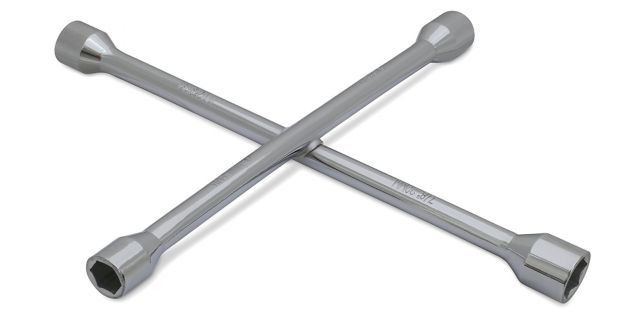Welcome to the Thomas guide to the best lug wrench 2022. Thomas has been connecting North American industrial buyers and suppliers for more than 120 years. When you purchase products through our independent recommendations, we may earn an affiliate commission.
Whether you are replacing a flat tire on the side of the road, doing a routine tire rotation, or loosening a lug nut that was put on way too tight, a lug wrench is going to be your go-to tool. It is a simple tool, yet so versatile, as it can be used on all vehicles including light trucks, cars, and even ATVs.
A lug wrench is one of those tools that should be in your trunk at all timesImage credit: Shutterstock/Huitron and Huitron
Anyone with an automobile is going to need a quality lug wrench that they can depend on, but there are a plethora of different wrenches out there to choose from. Our buying guide will help you pick the right tool for you.
Lug wrenches are socket wrenches specifically used to tighten or loosen a lug nut that is found most commonly on tires. They are typically stored in the trunk of a vehicle in case of an emergency, like a flat tire, but they are also very useful for professional mechanics who use the tool regularly.
There are many different types of lug wrenches to know about. First of all, you have your basic cross or 4-way wrench. This is a universal wrench, making it a great option for mechanics who need to accommodate many different lug nut sizes in a day’s work. It is also a good option for the average vehicle owner who wants to make sure they get a perfect fit, as this wrench works for most popular lug nuts.
There is also the L-shape wrench, but the sockets fit only one size of lug bolts. On the other hand, these lug wrenches often double as a tire iron with a prying tip on the other end.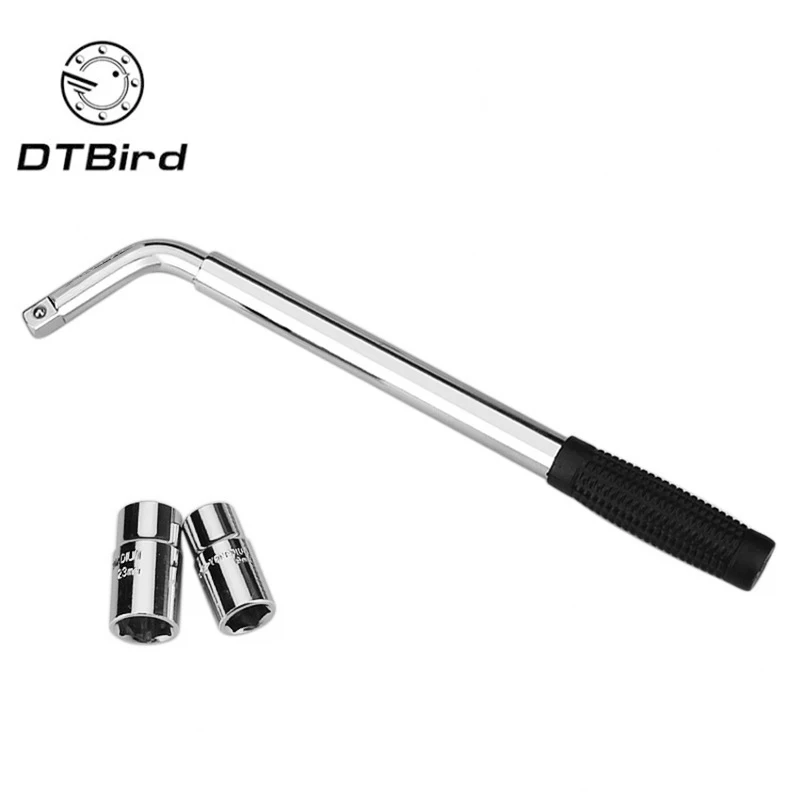
For stubborn lug nuts, you may want to look into buying a breaker bar. Although breaker bars are not exactly lug wrenches, they are good alternatives to a standard wrench if you have to break a frozen bolt. Their extra length can get you maximum leverage to remove lug nuts.
Now, if you only want to tighten lug nuts instead, a torque wrench is what you want. With this tool you can adjust the amount of torque to avoid loose nuts. Although this tool is different and a bit more expensive than a standard lug wrench, it is a reasonable price to pay for a more professional tool when compared to an impact wrench.
If you’re looking for a reliable lug wrench to have in your trunk or even one for the shop or garage, take a look at our list below for some of the top-rated lug wrenches and best lug wrenches to give you a mechanical advantage.
Best Rated Lug Wrench: Cartman Universal 4-Way Cross Lug Wrench | Buy Now Best High-Quality Lug Wrench: GTE Tools Universal Lug Wrench Set | Buy Now Best Lug Wrench with Thin Wall Sockets: Dorman Lug Wrench | Buy Now Best Drop Forged Lug Wrench: Ken-Tool 4-Way Lug Wrench | Buy Now Best Easy to Store Lug Wrench: EPAuto Telescoping Wheel Wrench | Buy Now Best Tire Iron: Red Hound Auto Lug Wrench | Buy Now Best Chrome Plated Lug Wrench: EPAuto 4-Way Cross Wrench | Buy Now Best Lug Wrench with Telescoping Handle: Cartman Telescoping Lug Wrench | Buy Now Best Torque Wrench for Lug Nut: ARUCMIN ½-Inch Drive Click Torque Wrench | Buy NowScroll down to find out more about these best-rated items and what reviewers have to say about them.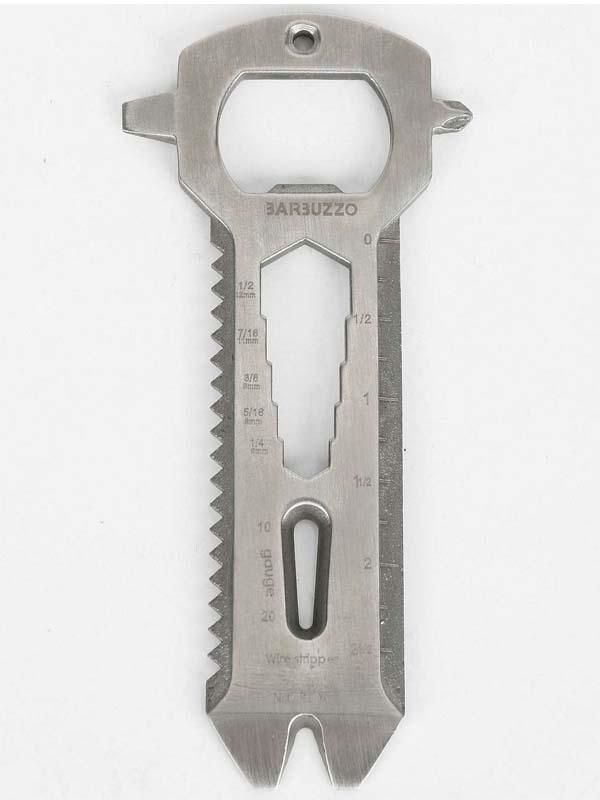
*Prices listed in this article were as shown in US$ on Amazon.com (USA) as of May 2022
As an Amazon’s Choice product and with 4.6 out of 5 stars from over 5,700 global ratings, the Cartman universal cross lug wrench seems to live up to the hype with many desirable features. The tool has anti-slip handles, a 4-way cross style, and a 16-inch design, which, when put together, allows users to get a firm grip to deliver a ton of strength when working with tough nuts. As one customer confirmed, “The extra length gives you a lot more torque, and the grips help on hot days when your palms might be sweaty.”
Beyond its anti-slip grip and ability to provide maximum leverage, this high-performance tool is also universal and designed with four socket heads to accommodate most lug nuts. The same customer went on to write that the tool “covers all the common sizes and the sockets are deep enough to get over the ball cap on my lug nuts.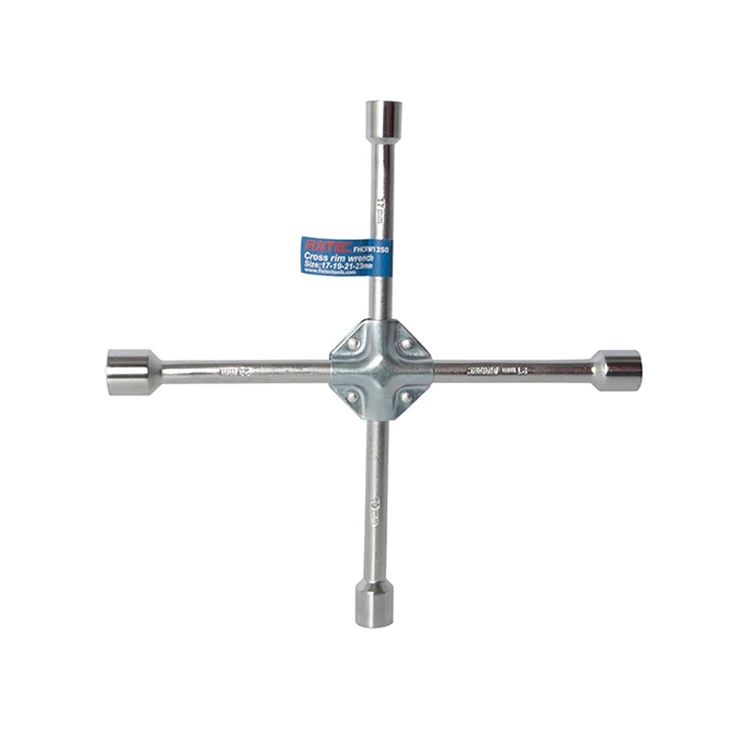 ”
”
Specifications
Length: 16 inches
Socket Sizes: 17mm, 19mm, 21mm, and 22mm
Weight: 3 pounds
With its strong steel construction, the GTE universal lug wrench set is one of the most high-quality lug wrenches on our list. As one impressed buyer described, “This is a strong, durable tool, that is well thought out in its design.” The tool is constructed so users can break it down for easy storage in their vehicle or toolbox, and this reliable tool also comes with a lifetime warranty for extra peace of mind.
The wrench is universal and versatile; not only does it include three different socket sizes to accommodate standard lug nuts, plus an adapter to fit any other lug sizes, but it also doubles as both an L-shaped lug wrench and a cross wrench, allowing users to get better leverage and providing maximum efficiency.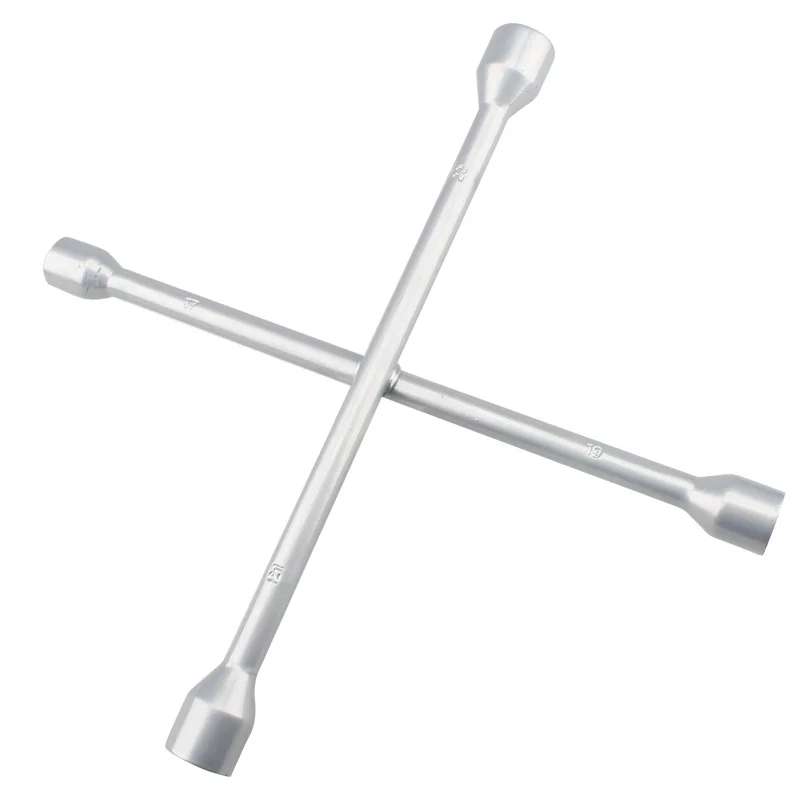 In relation to its sturdy locking mechanism, one customer mentioned that “the bar is cleverly designed to hold the sliding cross-bar in place.
In relation to its sturdy locking mechanism, one customer mentioned that “the bar is cleverly designed to hold the sliding cross-bar in place.
Specifications
Length: Red bar: 13 inches; Silver bar: 15 inches
Socket Sizes: 17mm, 19mm, and 21mm
Weight: 2.5 pounds
When it comes to a deep set lug nut that is just about impossible to access with a standard socket size, lug wrenches with thin wall sockets, like this Dorman lug wrench, will likely do the trick. With extra deep and thin sockets, this high-performance tool is suited for lug nuts with tight clearance, as many Amazon reviewers attested to. The lug wrench comes with two double-sided sockets that come in four different sizes.
The tool also features a telescoping handle that extends up to 20.5 inches allowing for more leverage. This prompted one customer to order “a second for my truck because the extra leverage makes tire change much easier.” Another reviewer commented, “This is a very good tool to get tight lug nuts off. I have had this for a few years and it has never failed to do the job.”
Specifications
Length: Collapsed: 15.75 inches; Fully extended: 20.5 inches
Socket Sizes: 17mm, 19mm, 13/16 inch, and ⅞ inch
Weight: 1.4 pounds
A drop forged lug wrench is able to withstand a lot more force than a welded wrench, which is why the Ken-Tool 4-way lug wrench will never bend or snap. As one customer confirmed, “This forged lug wrench can handle very large amounts of torque.” Another reviewer raved, “The shafts don't cross with a weld… They all connect via a center coupler that is solid as a rock!”
As one customer confirmed, “This forged lug wrench can handle very large amounts of torque.” Another reviewer raved, “The shafts don't cross with a weld… They all connect via a center coupler that is solid as a rock!”
This professional lug wrench is made of a hardened steel that is very strong and durable to ensure that it will last throughout the years. One buyer, a retired machinist, wrote that they “put it on the Rockwell hardness tester. It’s 58 on the ‘C scale.’ Very hard.” Although the price is a little steep, one customer shared that they have “used it over a dozen times and it still is in great shape. This was definitely worth the money.”
Specifications
Length: 23 inches
Socket Sizes: ¾-inch, 13/16-inch, ⅞-inch, and 15/16-inch
Weight: 4.35 pounds
 Best Easy to Store Lug Wrench—EPAuto Telescoping Wheel Wrench
Best Easy to Store Lug Wrench—EPAuto Telescoping Wheel Wrench For vehicles with little trunk space, a standard cross wrench might not be easy to store but the EPAuto telescoping lug wrench will be a perfect fit. This tool comes with a storage bag and has a telescoping handle that collapses to 13 inches for convenient storage in any small space. As one customer mentioned, “This wrench is great because it fits in the little storage compartment that my star wrench won't.”
While the tool makes for easy storage, when in use the handle can extend up to 19 inches for extra leverage. This product maintains extreme strength and durability since it is made from hardened chrome vanadium steel alloy. One user who needed the tool “to loosen some extremely frozen, 15-year-old, rusted bolts,” found that the wrench took care of these stubborn lug nuts and was able to handle a lot of pressure.
Specifications
Length: Collapsed: 13 inches; Fully extended: 19 inches
Socket Sizes: 17 mm, 19 mm, 21 mm, and 22 mm
Weight: 2. 29 pounds
29 pounds
If you ever find yourself on the side of the road dealing with a flat tire, not only are you going to want to have a lug wrench to loosen lug nuts but you also need a tire iron to remove your hub caps. This Red Hound Auto lug wrench is a great two-in-one. The tool is an L-shaped lug wrench with a 21 mm socket on one end and a prying tip on the other.
This wrench is only 13 inches long, allowing it to be, as one customer mentioned, “Compact and easy to store.” The tool is made of automotive-grade steel that will hold up under lots of pressure and will be able to withstand lots of use.
Specifications
Length: 13 inches
Socket Sizes: 21mm
Weight: 1. 2 pounds
2 pounds
Chrome-plated tools tend to last longer as they don’t end up rusty and corroded as other tools may. That is why the chrome plating on the EPAuto 4-way lug wrench makes the product a great buy. It is also made from steel construction, forged, and heat-treated, providing a good amount of strength and durability to deal with tight lug bolts. As one customer reported, “I could not budge these lugs with a 17mm socket wrench and this lug wrench did the trick, easily.”
This tool allows for even more efficiency with its engraved SAE and metric socket sizes, allowing users to quickly find the right size socket for the job. At only 14 inches in size, this wrench is perfect for compact storage as one customer mentioned, “This heavy chromed 4-way wrench fits in my trailer jockey box. It is small but heavy duty and will get the job done.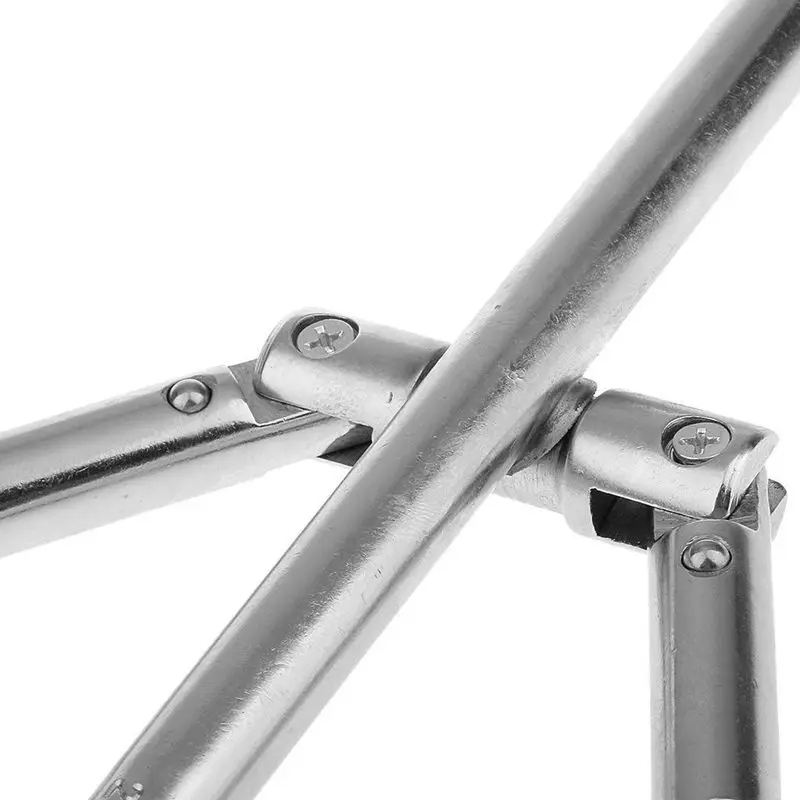 ”
”
Specifications
Length: 14 inches
Socket Sizes: 17mm, 19mm, 21mm, and 22mm
Weight: 2.57 pounds
With a telescoping handle that collapses down to 14 inches and comes with a quality storage bag, the Cartman telescoping wrench saves a ton of space. One customer wrote, “Having a compact, easy-to-store tool... is nice, saves time, and eliminates having to carry a bulky 4-way lug wrench.” The handle then can extend to 21 inches to allow for great torque and maximum leverage.
This tool is constructed from hardened steel, making it very strong and durable. One buyer commented, “It did the job [of] loosening the previously impact wrench-tightened lugs with minimal effort,” adding, “The bar felt sturdy after loosening and tightening 20 lug nuts.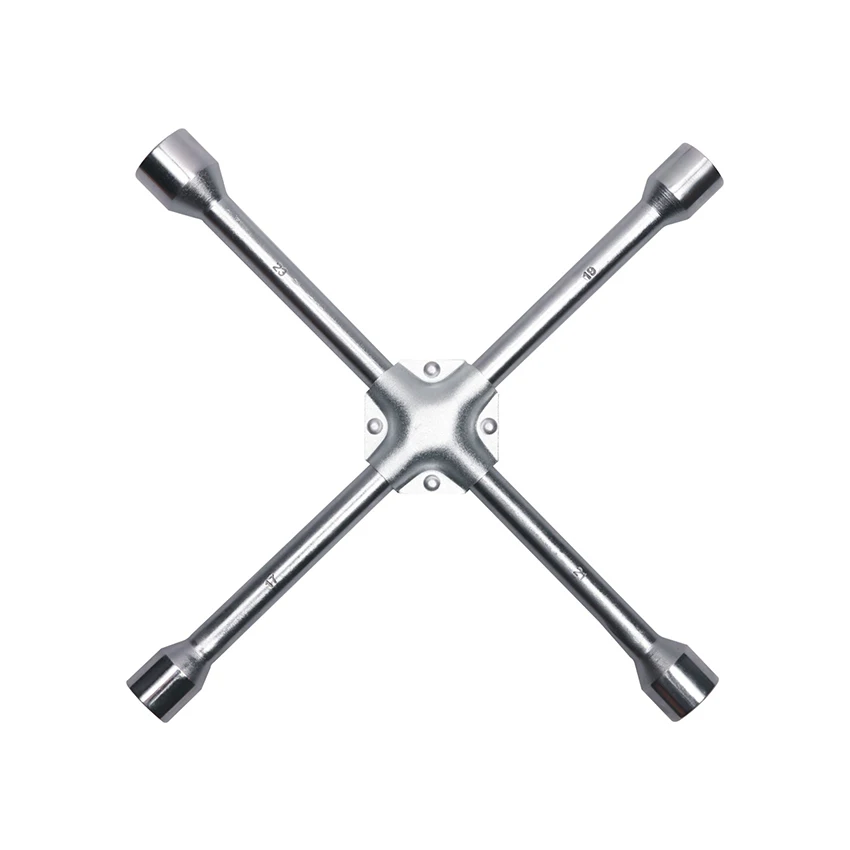 ” This wrench comes with two sockets that are double-sided, allowing it to fit many lug nut sizes.
” This wrench comes with two sockets that are double-sided, allowing it to fit many lug nut sizes.
Specifications
Length: Collapsed: 14 inches; Fully extended: 21 inches
Socket Sizes: 17mm, 19mm, 21mm, and 22mm
Weight: 2.2 pounds
When using standard lug wrenches for tightening lug nuts, there is a lot of guessing that goes into the whole thing in order not to over-tighten the bolts. The ARUCMIN wrench simplifies that process and allows users to set their torque from 10 to 150 ft-lbs. With an accuracy error within ± 4% and an easy-to-read laser scale, many customers felt that they can trust the exact reading.
Most notably, reviewers have raved that the product is extremely easy to use, and, as one customer confirmed, “I simply listen for the ‘click’ after I have set it to what I need—then I know to stop.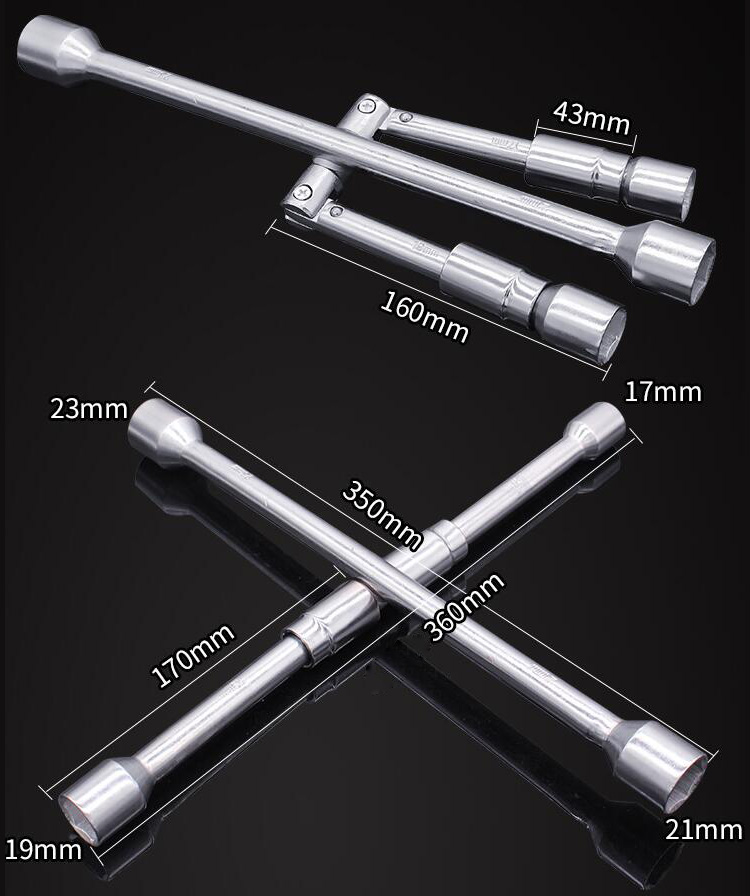 .. I have no more worries.” The set even comes with a durable storage box for convenient storing and protection.
.. I have no more worries.” The set even comes with a durable storage box for convenient storing and protection.
Specifications
Length: 17.2 inches
Socket Sizes: ¾-inch and 13/1-inch
Weight: 2.87 pounds
If you are looking for a tool with a comfortable grip, the Cartman universal lug wrench (US$15.99, Amazon) is the way to go. Its anti-slip rubber handle provides a good grip for improved performance. This tool also has four different lug sizes to fit most standard nuts, making it a great buy. But if storage space is a big concern, a small wrench like the EPAuto lug wrench with a telescoping handle (US$15.97 (Was US$19.99), Amazon) may be a better option. The wrench also comes with two double-sided sockets for added versatility as well.
We hope our review of the best lug wrenches has been helpful. For more similar suppliers, including suppliers of socket sets, socket wrenches, deep socket wrenches, and impact wrenches, consult our additional guides or visit the Thomas Supplier Discovery Platform.
Machinery, Tools & Supplies
Machinery, Tools & Supplies
Machinery, Tools & Supplies
Machinery, Tools & Supplies
Machinery, Tools & Supplies
Machinery, Tools & Supplies
Written By Car Bibles Staff
Updated Jul 13, 2022 8:59 AM
A lug wrench is one of the simplest tools in your armory, but it can also be one of the most effective. At home, it is on hand to help you tackle lug nuts and bolts so you can work on your wheels, brake and suspension systems. When you are out and about, a high-quality lug wrench can be a lifesaver if you experience a blowout and need to do a roadside tire repair.
At home, it is on hand to help you tackle lug nuts and bolts so you can work on your wheels, brake and suspension systems. When you are out and about, a high-quality lug wrench can be a lifesaver if you experience a blowout and need to do a roadside tire repair.
In this guide we take a look at the best lug wrenches on the market right now. We evaluate the pros and cons of each one and take a deep dive into the features you need to look out for when selecting the right wrench for you.
Some of the best lug wrench designs employ a collapsible design, and that is exactly what we have in this product from CARTMAN. In its closed form it measures a tiny 13 inches, but it can extend out to 21 inches when you need to use it. Along with the handy (and protective) storage bag, this tire wrench is easy to store in a vehicle but still can give the length to provide the leverage you need to tackle stubborn bolts.
The only small issue is with the sockets that come with this wrench.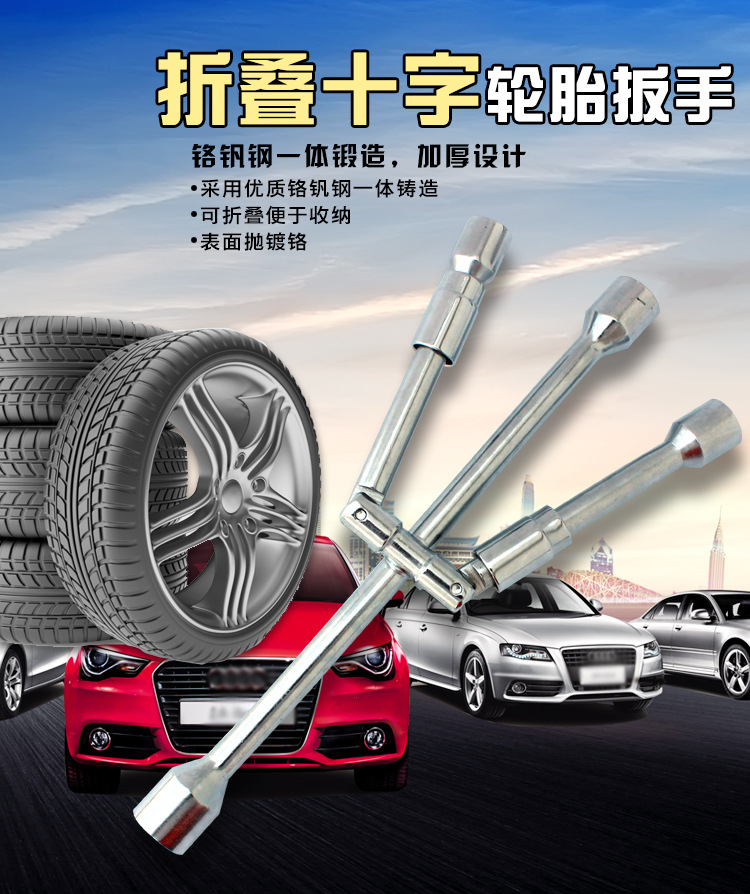 You do get four of them in the most common used sizes, but they are not quite as deep as you will find with some other models. It probably won’t make a huge difference to the use of the wrench but is something to keep in mind.
You do get four of them in the most common used sizes, but they are not quite as deep as you will find with some other models. It probably won’t make a huge difference to the use of the wrench but is something to keep in mind.
Key Features
Specification
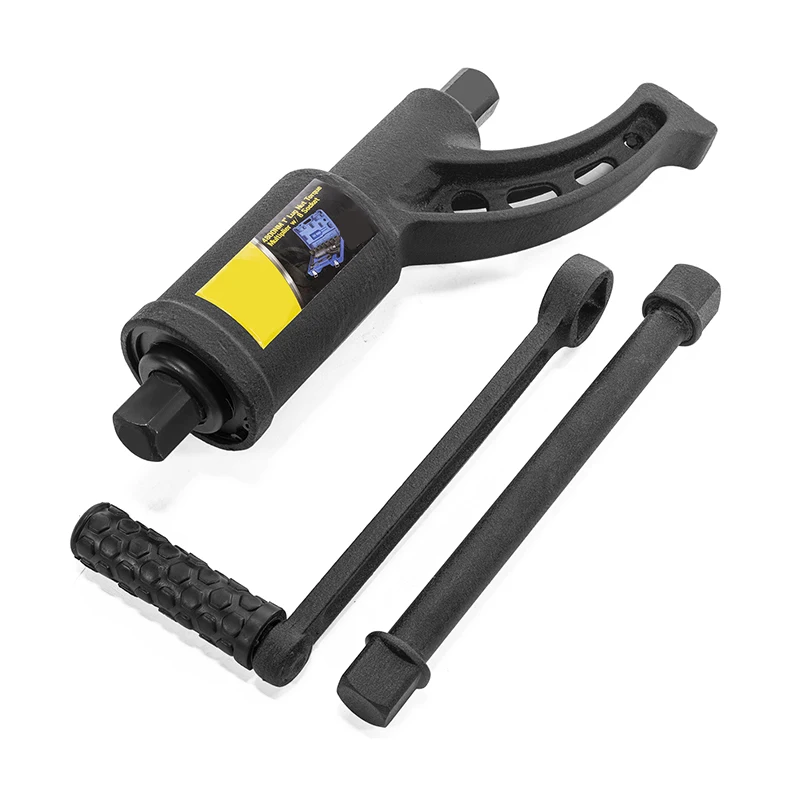 2 pounds
2 pounds PROS
Small & Easy to Store
Extends for Extra Leverage
Great Value for Money!
CONS
Bits are a Strange Shape
Next we have this design from Powerbuilt. It is of the traditional, cross style of lug wrenches, a design we will see more than once as we move through the list. As for price, this particular one is toward the top end of the mid-range when it comes to four-way tire iron designs.
For that money you get a nice and solid design. It is chrome plated and highly polished, so you get a very attractive shiny surface that is very resistant to rust and water damage. For a tool that could be stored in the trunk for prolonged periods without being used, that’s useful to see. You get your standard four socket sizes, so you should have everything you need to tackle most automotive jobs.
The arms are a little thin and have no padding or protection. If you are extorting a lot of pressure on a stubborn nut you could find those skinny arms biting into your palms a little.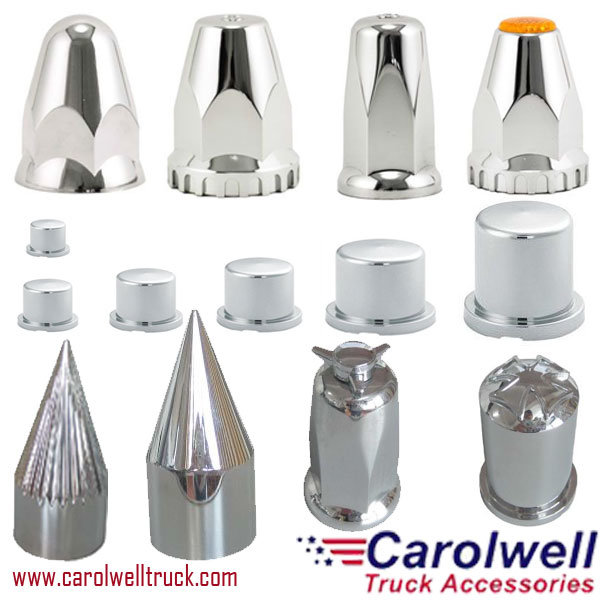 We looked at the 20” option, but it is also available in a 14” (easier storage, less leverage) and a 25” for extra leverage for really stubborn bolts and nuts. All in all, it is a very useful, well-designed and simple tool.
We looked at the 20” option, but it is also available in a 14” (easier storage, less leverage) and a 25” for extra leverage for really stubborn bolts and nuts. All in all, it is a very useful, well-designed and simple tool.
Key Features
Specification
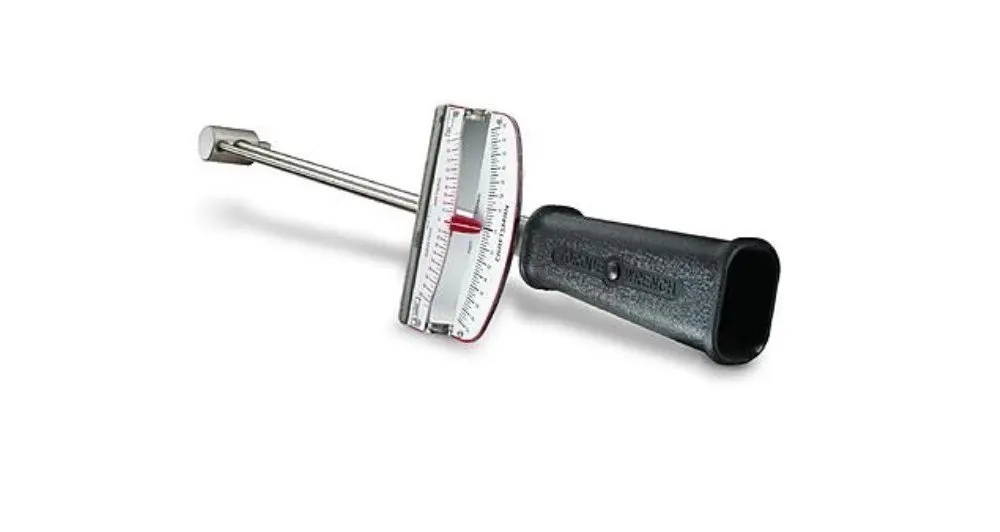 5 Lbs
5 Lbs PROS
Very Simple to Use
Extremely Tough & Long Lasting Design
Solid And Dependable
CONS
Thin & Unpadded Arms
Only 20 Inches of Leverage
If we were going to trust any mammal to build top-quality vehicular tools, it would probably be a gorilla. So we were pleased to come across this item, a telescoping lug wrench from Gorilla Automotive.
Again, this design is ideal for in-car storage. It is great to see this product shrink down to 14 inches, and it weighs less than three pounds. It really is nice and small. It has a double-sided socket design too, so you only have to find space to store two sockets.
At the same time, it boasts a tough construction of hardened steel and also extends to 21 inches. That is a level of toughness and length that should provide the strength and durability to tackle a range of nuts of various tightening levels. It is certainly not the cheapest lug wrench on the market – it is in fact one of the more expensive.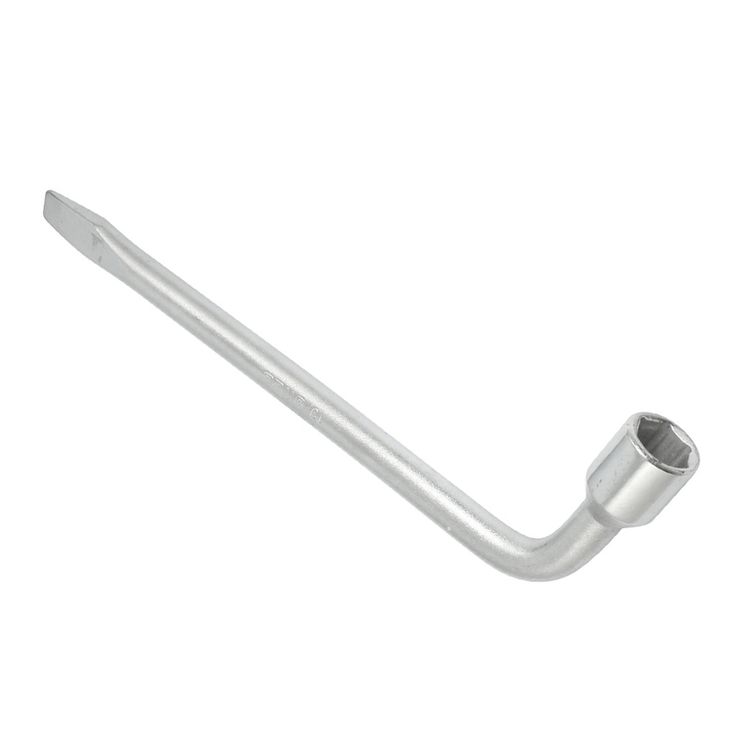 But you get a very well-designed, very tough tool for your money.
But you get a very well-designed, very tough tool for your money.
Key Features
Specification
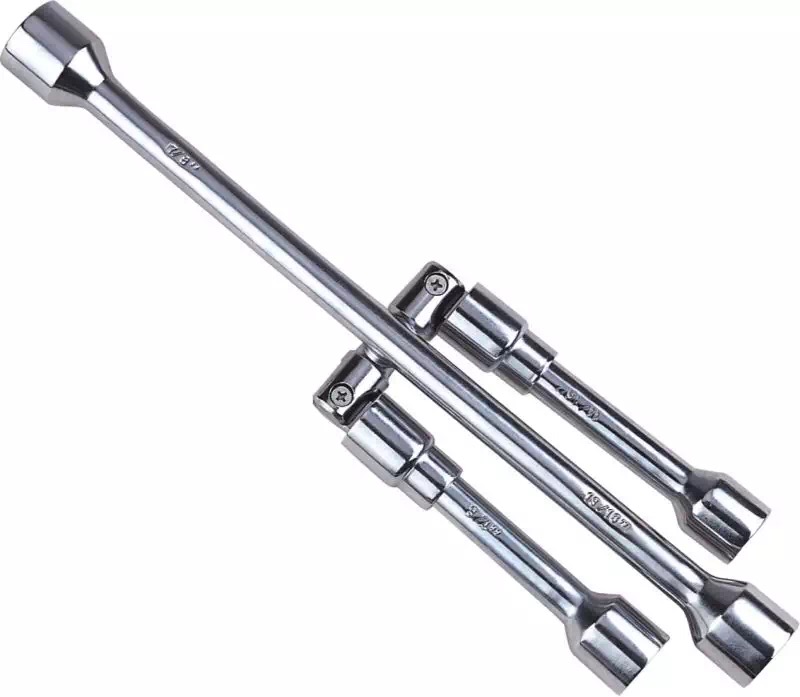 75 Lbs
75 Lbs PROS
Extends to 21”
Very Tough
Free Storage Bag!
CONS
High Price
Our next product is this four-way lug wrench from GTE Tools. A couple of notes right up front, though. First, this is certainly a premium product with the premium price tag to match. It is also a very well-designed little tool with a number of useful features.
The most useful has to be the fact that the tool collapses. It doesn’t go into itself like one of the extending versions, rather the central section unscrews and can be stored inside the other handle. You can keep it stored in its handy storage bag. It is still a pretty large tool at 26” long. But it’s easier to store then when in its assembled size.
It comes with the usual socket sizes plus a universal adaptor that you can attach to bits from a multi-tool. That is a very handy feature you don’t see on to many lug wrenches. As you would expect from this price point, the tool is well made of hardened steel so it has the toughness and durability to tackle a range of jobs.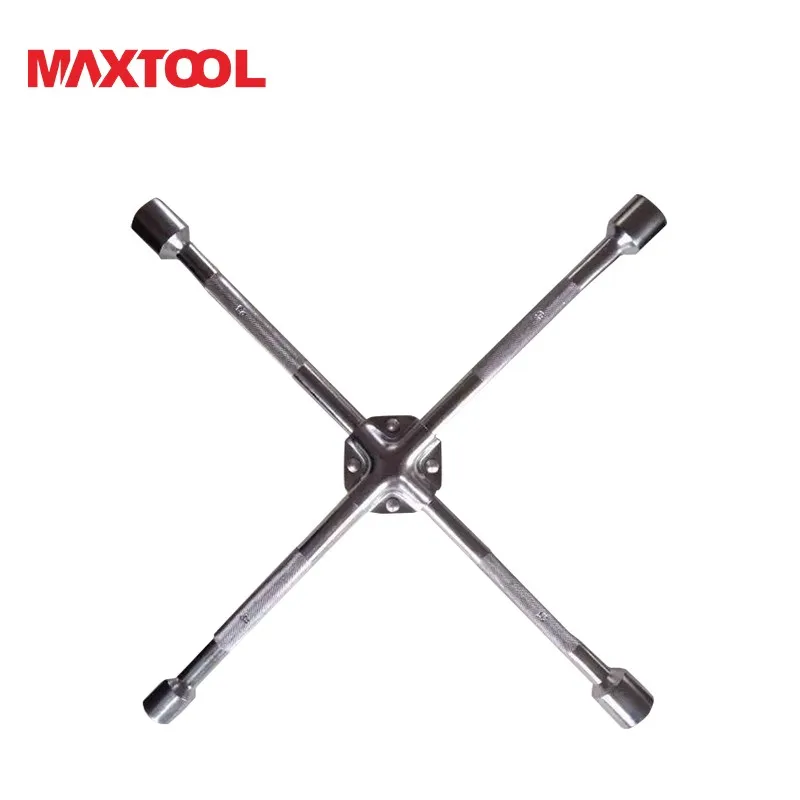
It is going to put a dent in the bank balance for sure, but this premium tool certainly has the design features to justify the expenditure.
Key Features
Specification
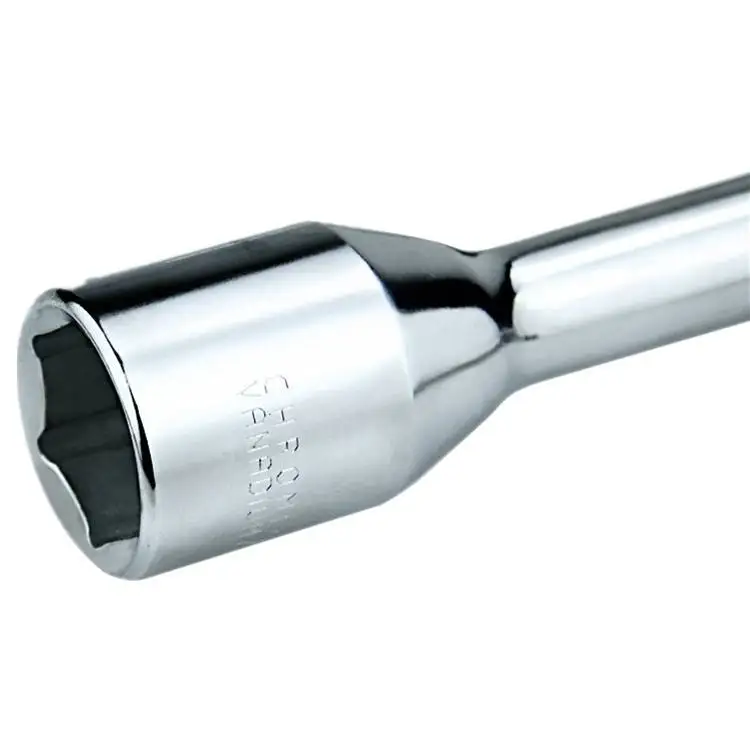 5 lbs
5 lbs PROS
Extra Long for Extra Leverage
Multiple Uses
Very Tough Steel Construction
Breaks Down for Easy Storage
CONS
Premium Price Tag
Large Sized Tool
The next tool to make the list comes from a company called Performance Tool, so lets hope it lives up to its name. Here’s another lug wrench with mobility and ease of storage at the heart of the design. As you will see it has gone a slightly different route.
This product has two folding arms that extend to provide leverage when tackling lug nuts. They fold back into the side of the tool for ease of storage. It’s also worth pointing out that the tool is one of the smallest and lightest on the list, weighing in at only 1.7 pounds.
On the one hand that makes it very easy to store in a vehicle – you could find room in even the smallest compact car for this tiny tool. On the other hand it may not have the heft to regularly tackle well-tightened nuts. In particular, the hinged arm attachments have to bear a lot weight, and they may not live up to daily use. As a lug wrench to store in the vehicle for emergencies though it is lightweight, easy to use, easy to store, and relatively cheap.
In particular, the hinged arm attachments have to bear a lot weight, and they may not live up to daily use. As a lug wrench to store in the vehicle for emergencies though it is lightweight, easy to use, easy to store, and relatively cheap.
Don’t buy this for your garage then, but certainly consider it as an investment to upgrade your roadside repair kit stored in the car.
Key Features
Specification
 7 Pounds
7 Pounds PROS
Very Small & Light
Easy to Store
Decent Value for Money
CONS
May Lack Strength for High Pressure Bolts
Thin Arms May Bite into Hands
Cartman is back with its second entry to make the list. A far more traditional and straightforward design than what we saw before, what we have here is a nice and simple four-way lug wrench.
That being said, Cartman has gone the extra mile to add a few extra useful features. The big standout is the anti-slip protection. In reality these are merely plastic sleeves inserted over the four arms of the wrench. While being a very simple addition, they are also very effective, adding more grip and surface area for a tool that is easier to hold and use. It is also good to see that chrome plating has been employed in the finish to protect against rust and corrosion.
A 16” arm span is definitely toward the smaller end when it comes to these types of tools. That does make it easy to store and easy to work with in confined spaces. It also means that it takes more effort on your part to generate the leverage required to tackle really stubborn lug nuts.
That does make it easy to store and easy to work with in confined spaces. It also means that it takes more effort on your part to generate the leverage required to tackle really stubborn lug nuts.
Key Features
Specification
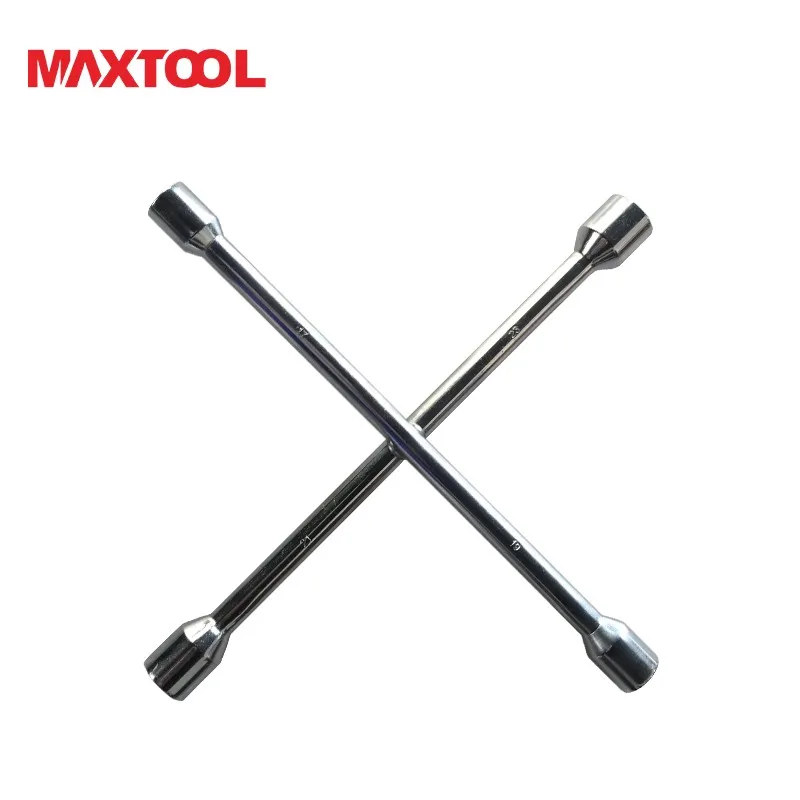 33 Lbs
33 Lbs PROS
Tough Design
Effective Anti-Slip Coating
Simple But Effective Design
CONS
Only 16” Span
Quite Heavy
Regular Car Bibles readers – which we assume is all of you, right? – are used to seeing products from EPAuto show up on our lists. It makes simple but effective automotive tools, so you can pretty much expect what’s coming next.
This lug wrench, from EPAuto, is both simple and effective. We’ll give you a moment to come to terms with that revelation. All jokes aside, this is a very solid little tool, which is well made and extremely tough. It comes with the four standard socket sizes you expect, and it is also chrome plated for rust and corrosion protection. It also has a low price tag, so it’s very good value for the money.
Notice how we said it is a little tool? Well, we weren’t being cute. With an arm length of just 14” this is easily the smallest wrench – whether collapsible or a four-way lug wrench – to make the list. It is easy to store, whether in the garage or the trunk. On the other hand, it will be harder to generate the top levels of torque required to undo really tough lug nuts with this tool.
It is easy to store, whether in the garage or the trunk. On the other hand, it will be harder to generate the top levels of torque required to undo really tough lug nuts with this tool.
Key Features
Specification
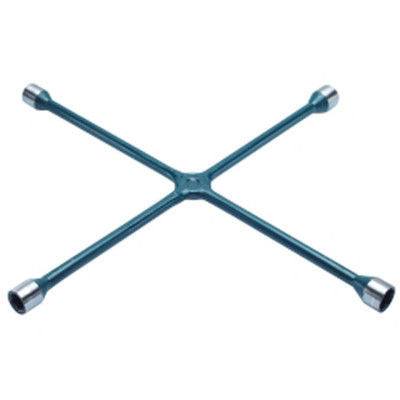 65 Lbs
65 Lbs PROS
Simple But Sturdy Design
Smaller than Many Other Cross Wrench Designs
Excellent Value for Money
CONS
Tough to Generate Lots of Power
Cartman is back with its third entry to the list. It is by far the most simple of its designs that we looked at, but it still packs the Cartman name as a badge of quality construction.
You can actually re-read the entry for the product above from EPAuto and simply replace its company name with Cartman. This is a short four-way lug wrench with a 14” span. So the same pros and cons apply here as with the product above. It is even a similar price.
The one big difference comes in its construction materials. This lug wrench is made of heat-treated carbon steel. We don’t need to tell you that this is a very tough material. Add in the chrome plating and you have a very simple but very strong and long-lasting tool that should give years of hassle-free service.
Key Features
Specification
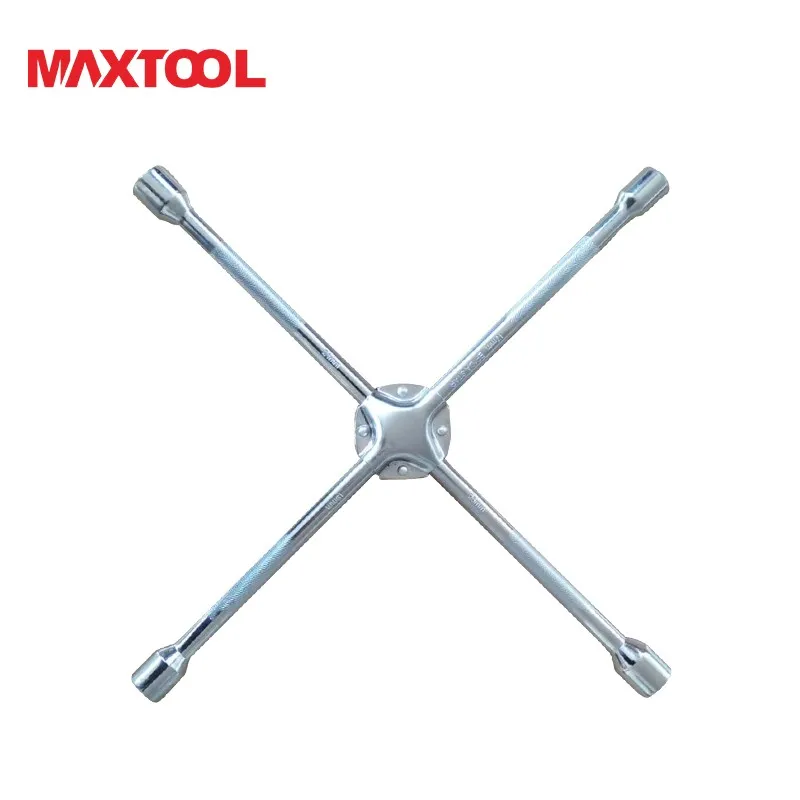 7 Lbs
7 Lbs PROS
Very, Very Tough
Small and Compact
Excellent Price Tag
CONS
Short Arms
The penultimate tire wrench to make the list is this useful little tool from Dorman. We are back to the extending style of lug wrench, and this is certainly an effective, if somewhat simple, example of that design.
It collapses to 15” for easy storage and extends out to around 21” to provide extra leverage when tackling tougher lug nuts. It comes bundled with a pair of double-sided sockets of standard size. The double-sided sockets do keep down the space the tool occupies, although it’s a shame there is no free storage bag with this tool. The handle is nice and comfortable and deeply etched to provide a good grip. That is certainly useful when changing a tire at the roadside on a winter’s night.
All in all though it is a pretty simple design. There is, for example, no locking mechanism for the extending arm. That’s not exactly a deal breaker but it does mean this tool is not quite as easy to use as some other folding designs we’ve looked at on this list.
That’s not exactly a deal breaker but it does mean this tool is not quite as easy to use as some other folding designs we’ve looked at on this list.
Key Features
Specification
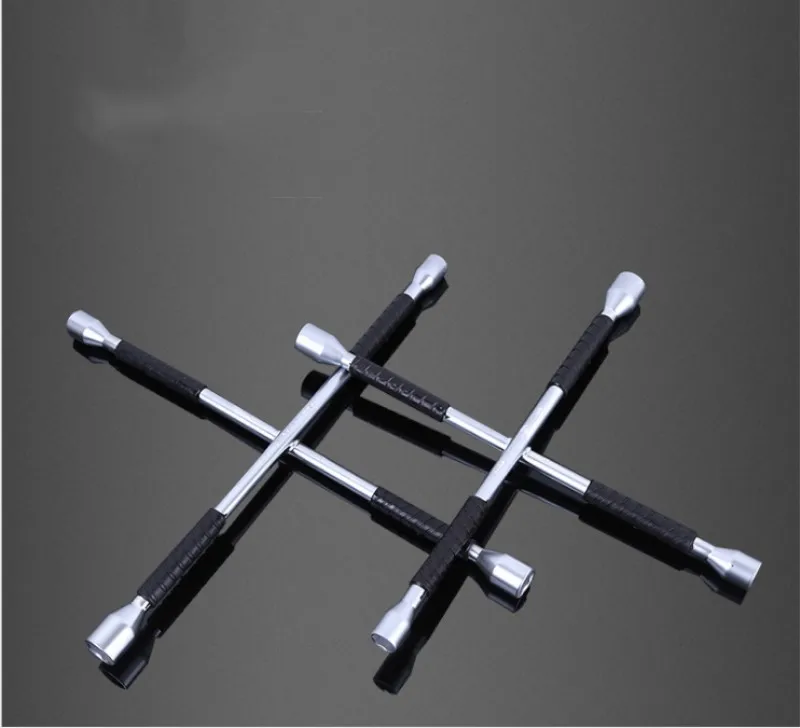 4 Lbs
4 Lbs PROS
Folds for Easy Storage
Comfortable Handle
CONS
No Storage Bag
No Locking Mechanism
The final tool is this four-way tire iron from OEMTOOLS. If there is one thing we are sure about this tool, it is the fact it is very, very green. That paint does help to make the tool nice and visible, and you probably won’t misplace it in even the messiest garage. On the other hand, the color scheme is probably not going to be for everyone.
Aside from the color scheme there is a lot to like. This cross wrench has 20” arms, far longer than the standard 14” we’ve seen so far. That’s going to make it easy to generate lots of torque to tackle rusted or stubborn bolts. The construction features heat-treated carbon steel for a tough and resilient tool. The sockets are universal size and also quite deep.
This is a premium level lug wrench and certainly one of the top cross wrench designs we’ve looked at. It costs a little more than the standard cross wrench but is not earth shatteringly high. Whether you like the color or not will be a personal preference, but underneath it is a very well made lug wrench.
It costs a little more than the standard cross wrench but is not earth shatteringly high. Whether you like the color or not will be a personal preference, but underneath it is a very well made lug wrench.
Key Features
Specification
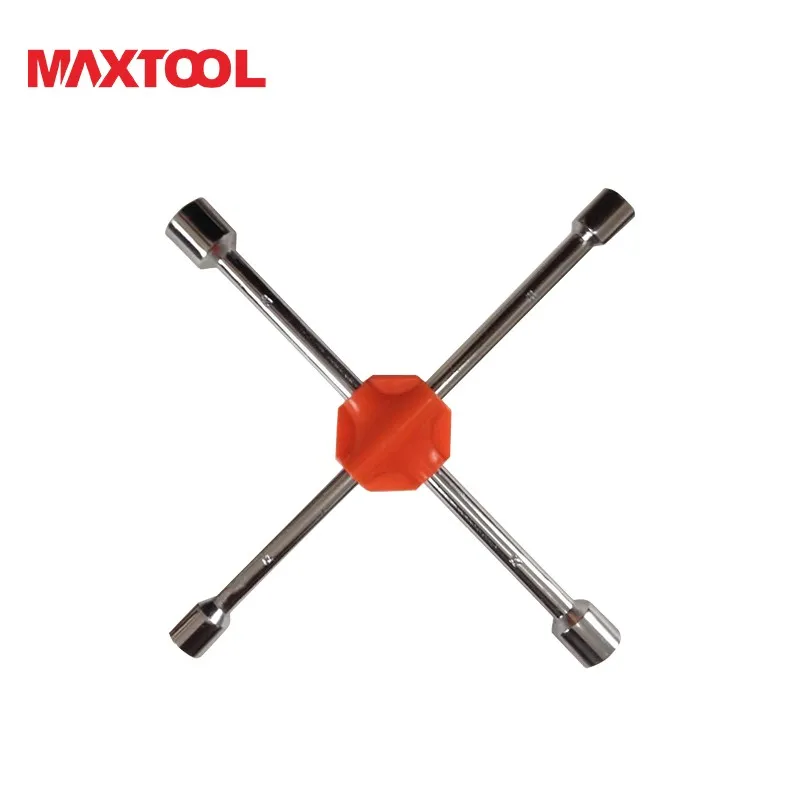 75 Lbs
75 Lbs PROS
Eye Catching Color
Length Helps Generate Torque
Very Durable Construction
CONS
Color Scheme Won’t be For Everyone
High Price
Quite Heavy
In our buying guide, we’ll take you through the features that you should keep an eye out for when picking out the best lug wrench for you. After that, we’ll take a look at how best to use your new toy and answer some of the most frequently asked questions about this extremely useful tool.
What is a Lug Wrench?A lug wrench is a hand-operated tool used to remove lug bolts. It’s most usual function will be in helping to remove and reattach the wheels on your car. That’s… about it really. This is one of the most widely recognized automotive tools around, but its uses are fairly specific.
What to Consider When Buying a Lug Wrench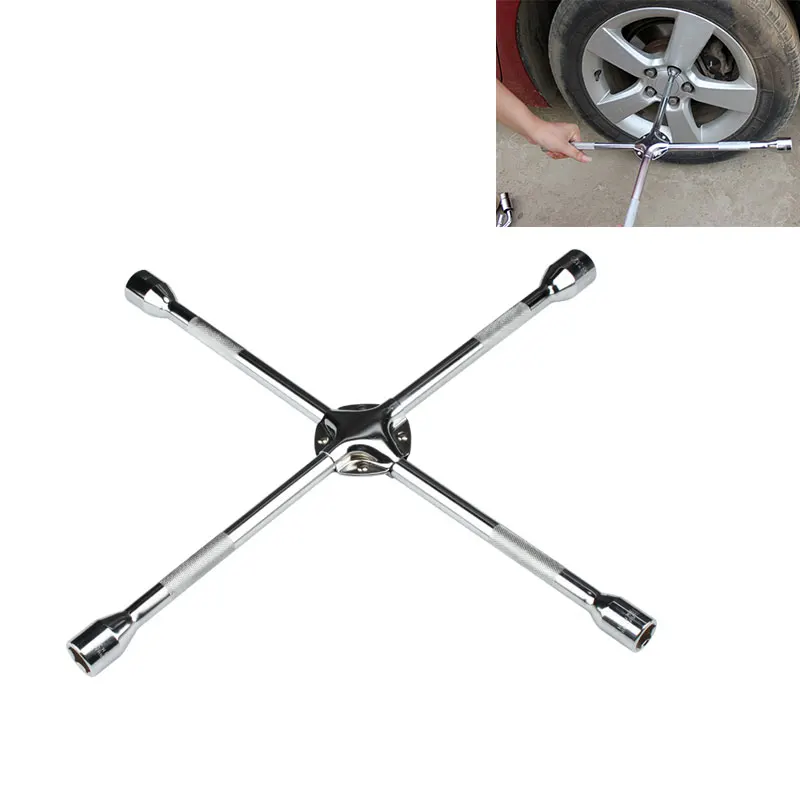 Everything we looked at comes as a set, and frankly we wouldn’t put down hard earned cash for a wrench that wasn’t a kit. It just seems mean.
Everything we looked at comes as a set, and frankly we wouldn’t put down hard earned cash for a wrench that wasn’t a kit. It just seems mean.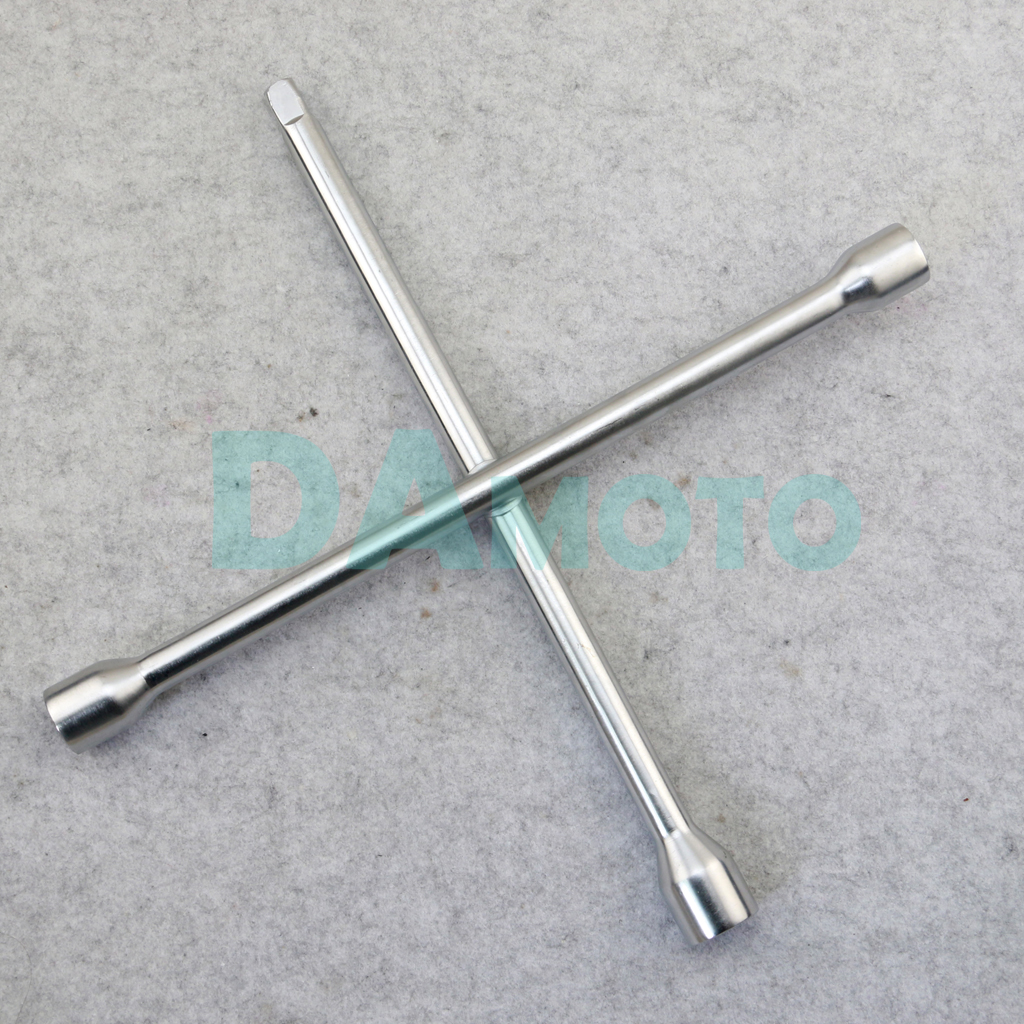 If you are looking for a lug wrench to keep in your vehicle for emergencies, this is a big consideration as the smaller it is, the easier it will be to find a home in the vehicle.
If you are looking for a lug wrench to keep in your vehicle for emergencies, this is a big consideration as the smaller it is, the easier it will be to find a home in the vehicle.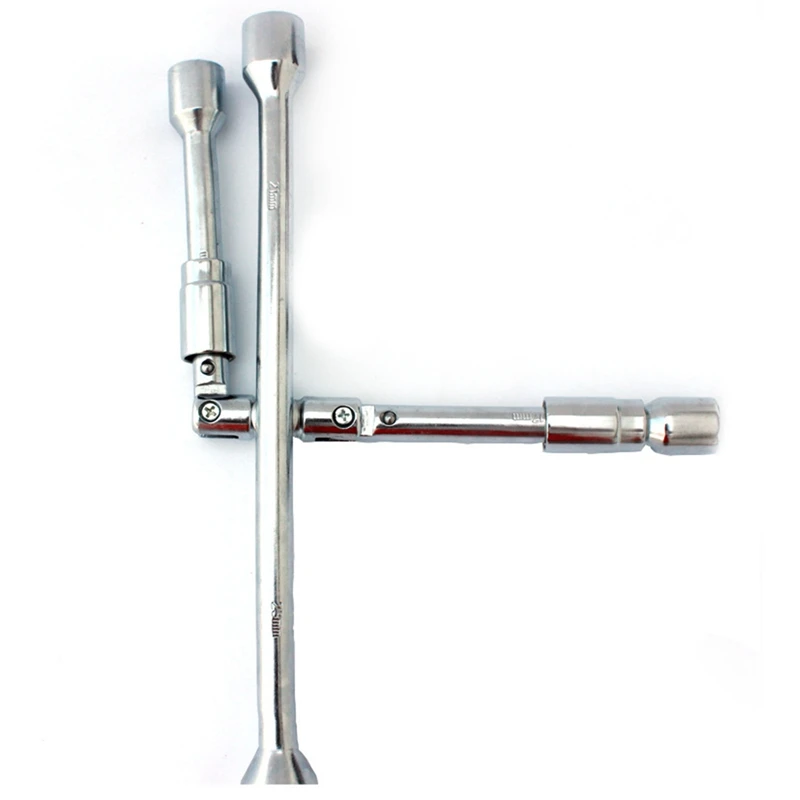 It is though harder to store, especially in the car. A folding model, whether it folds in half or extends from itself, will of course be easier to find a home for. But it may struggle to provide the same power and leverage for everyday use as a solid design.
It is though harder to store, especially in the car. A folding model, whether it folds in half or extends from itself, will of course be easier to find a home for. But it may struggle to provide the same power and leverage for everyday use as a solid design.A lug wrench is to a powered impact wrench what a manual screwdriver is to a power tool. By that we mean that the lug wrench and the impact wrench both perform the same function, but one uses a built in motor and the other uses you as the source of power.
Because of this, a lug wrench will generally not be able to generate the same power and torque as its powered cousins – especially air powered impact wrenches. There is a reason that when F1 or NASCAR racing cars pull into the pits, you don’t see some poor guy down on his knees desperately trying to get the wheels off with a lug wrench.
The best lug wrench can still be a solid purchase however because, lets face it, most of us don’t work in pit stops. We have all Saturday afternoon to change our tires, not 0.8 seconds. A lug wrench can then have a number of advantages:
We have all Saturday afternoon to change our tires, not 0.8 seconds. A lug wrench can then have a number of advantages:
One of the beauties of these tools is that it is very simple to use. Slot the socket over the lug nut you want to loosen (or tighten) and twist in the right direction (remember – Lefty Loosey, Righty Tighty!)
That is pretty much it.
Remember to get your vehicle up on a jack stand before you remove the wheel. It can also be useful to have some old rags or towels on hand. When you are tackling a very stubborn bolt, you can wrap them around the lug wrench to provide a little cushioning and stop the wrench arms biting into the palms of your hands.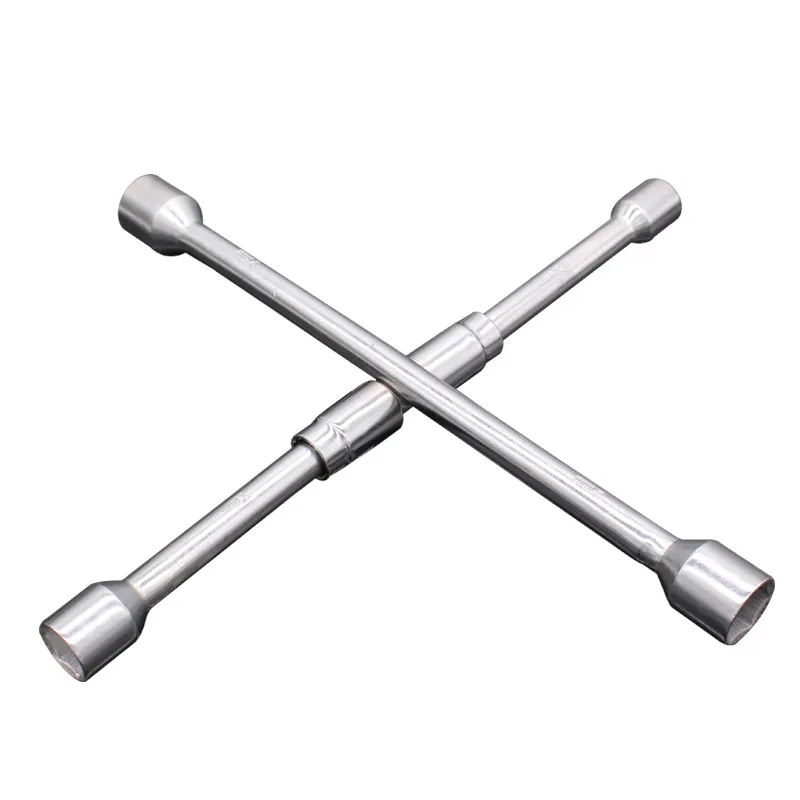
Here at Car Bibles, we do like a product that gives good value for money. That doesn’t mean being cheap though. What we mean is that we like a tool that gives a lot back for the money you invest in it. That’s why when it came time to pick the best lug wrench on our list, we went for the Cartman Telescoping Lug Wrench.
It has a very attractive price point of around 10 bucks, which by itself is great. It is also small enough to be easily stored away in the car for emergencies. At the same time, it extends (and has the toughness) to provide the leverage for tackling stubborn bolts. That means it can also be used in day-to-day vehicle maintenance. It is therefore well-priced and useful in a range of applications. Good stuff, Cartman.
Immediately after the release of the new OS, everyone became interested in how to find out the key of the installed Windows 10, although in most cases it is not required.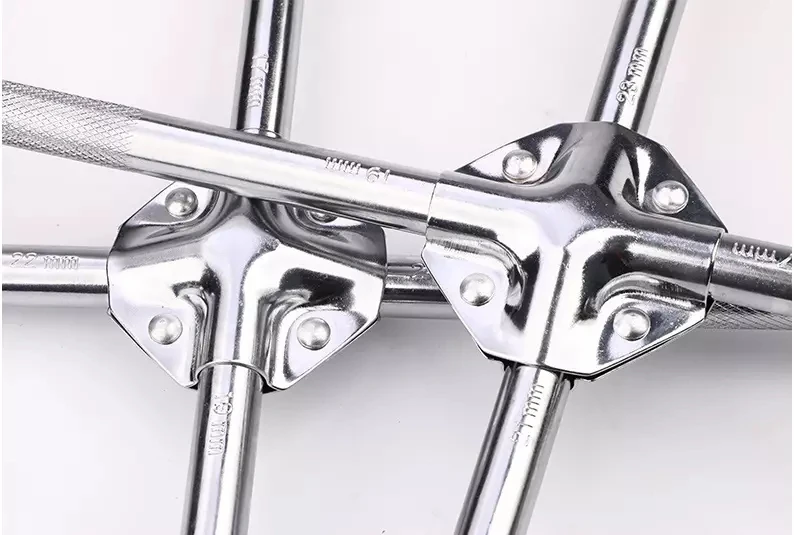 Nevertheless, if you still need a key for one purpose or another, it is relatively easy to determine it, both for the installed OS and the product key hardwired into UEFI by the manufacturer (they may differ).
Nevertheless, if you still need a key for one purpose or another, it is relatively easy to determine it, both for the installed OS and the product key hardwired into UEFI by the manufacturer (they may differ).
This guide provides easy ways to find your Windows 10 product key using Command Prompt, Windows PowerShell, and third-party programs. At the same time, I will mention why different programs show different data, how to separately view the OEM key in UEFI (for the OS that was originally on the computer) and the key of the currently installed system.
Note: if you upgraded to Windows 10 for free and now want to know the activation key for a clean installation on the same computer, you can do this, but this is not necessary (besides, you will have the key the same as other people who got a ten by updating). When installing Windows 10 from a flash drive or disc, you will be asked to enter a product key, but you can skip this step by clicking "I don't have a product key" in the prompt box (and Microsoft says you should).
When installing Windows 10 from a flash drive or disc, you will be asked to enter a product key, but you can skip this step by clicking "I don't have a product key" in the prompt box (and Microsoft says you should).
Once installed and connected to the Internet, the system will be automatically activated, since the activation is "bound" to your computer after the update. That is, the field for entering the key in the Windows 10 setup program is present only for buyers of Retail versions of the system. Optional: For a clean install of Windows 10, you can use a product key from a previously installed Windows 7, 8, and 8.1 on the same computer. More about such activation: Activating Windows 10. And if you wish, you can use Windows 10 without activation.
There are many programs for the purposes described here, many of which I wrote about in the article How to find the Windows 8 (8.1) product key (will work for Windows 10), but I More than others, I liked the recently found ShowKeyPlus, which does not require installation and separately shows two keys at once: the currently installed system and the OEM key in UEFI.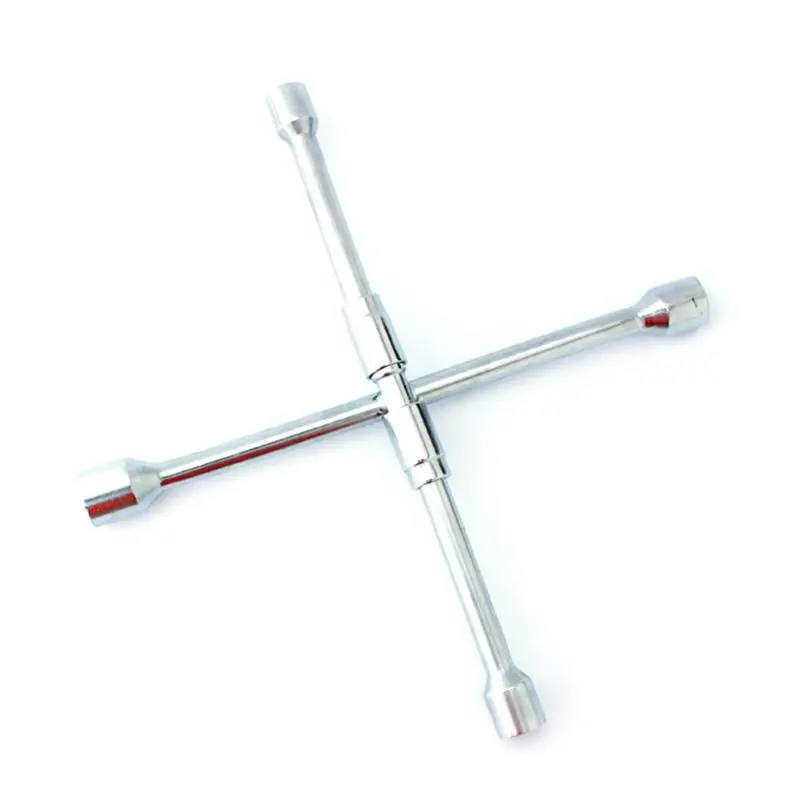 At the same time, it tells you which version of Windows the key from UEFI is suitable for. Also, using this program, you can find out the key from another folder with Windows 10 (on another hard drive, in the Windows.old folder), and at the same time check the key for validity (Check Product Key item).
At the same time, it tells you which version of Windows the key from UEFI is suitable for. Also, using this program, you can find out the key from another folder with Windows 10 (on another hard drive, in the Windows.old folder), and at the same time check the key for validity (Check Product Key item).
All you need to do is run the program and see the displayed data:
Also, this data can be saved to a text file for further use or archiving by clicking the "Save" button. By the way, the problem with the fact that sometimes different programs show different product keys for Windows just appears due to the fact that some of them look at it in the installed system, others in UEFI.
You can download ShowKeyPlus from https://github.com/Superfly-Inc/ShowKeyPlus/releases/
If for one reason or another ShowKeyPlus turned out to be an inappropriate option for you, you can use the following two programs:
Where third-party software is required, I prefer to do without.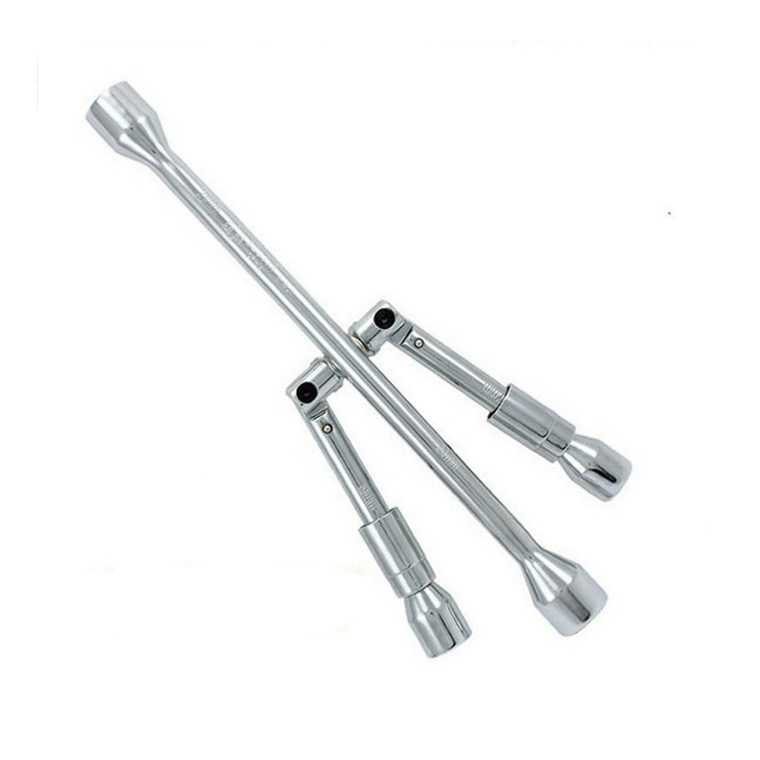 Viewing your Windows 10 product key is one such task. If you find it easier to use a free program for this, scroll through the guide below. (By the way, some key viewers send them to interested parties)
Viewing your Windows 10 product key is one such task. If you find it easier to use a free program for this, scroll through the guide below. (By the way, some key viewers send them to interested parties)
A simple PowerShell or command line command to find out the key of the currently installed system is not provided (there is such a command that shows the key from UEFI, I will show it below. But usually it is the key of the current system that is different from the preinstalled one). But you can use a ready-made PowerShell script that displays the necessary information (the author of the script is Jakob Bindslet).
Here's what you need to do. First of all, open notepad and copy the code below into it.
#Main function Function GetWin10Key { $hklm = 2147483650 $Target = $env:COMPUTERNAME $regPath = "Software\Microsoft\Windows NT\CurrentVersion" $DigitalID = "DigitalProductId" $wmi = [WMIClass]"\\$Target\root\default:stdRegProv" #Get registry value $Object = $wmi. GetBinaryValue($hklm,$regPath,$DigitalID) [Array]$DigitalIDvalue = $Object.uValue #If get succeeded If($DigitalIDValue) { #Get product name and product ID $ProductName = (Get-itemproperty -Path "HKLM:Software\Microsoft\Windows NT\CurrentVersion" -Name "ProductName").ProductName $ProductID = (Get-itemproperty -Path "HKLM:Software\Microsoft\Windows NT\CurrentVersion" -Name "ProductId").ProductId #Convert binary value to serial number $Result = ConvertTokey $DigitalIDvalue $OSInfo = (Get-WmiObject "Win32_OperatingSystem" | select Caption).Caption If($OSInfo -match "Windows 10") { if($result) { [string]$value ="ProductName : $ProductName `r`n" ` + "ProductID : $ProductID `r`n" ` + "Installed Key: $Result" $value #Save Windows info to a file $Choice = GetChoice If( $Choice -eq 0 ) { $txtpath = "C:\Users\"+$env:USERNAME+"\Desktop" New-Item -Path $txtpath -Name "WindowsKeyInfo.txt" -Value $value -ItemType File -Force | Out-Null } Elseif($Choice -eq 1) { exit } } Else { Write-Warning "Run a script on Windows 10" } } Else { Write-Warning "Run a script on Windows 10" } } Else { Write-Warning "An error occurred, unable to get key" } } #Get user choice Function GetChoice { $yes = New-Object System.
GetBinaryValue($hklm,$regPath,$DigitalID) [Array]$DigitalIDvalue = $Object.uValue #If get succeeded If($DigitalIDValue) { #Get product name and product ID $ProductName = (Get-itemproperty -Path "HKLM:Software\Microsoft\Windows NT\CurrentVersion" -Name "ProductName").ProductName $ProductID = (Get-itemproperty -Path "HKLM:Software\Microsoft\Windows NT\CurrentVersion" -Name "ProductId").ProductId #Convert binary value to serial number $Result = ConvertTokey $DigitalIDvalue $OSInfo = (Get-WmiObject "Win32_OperatingSystem" | select Caption).Caption If($OSInfo -match "Windows 10") { if($result) { [string]$value ="ProductName : $ProductName `r`n" ` + "ProductID : $ProductID `r`n" ` + "Installed Key: $Result" $value #Save Windows info to a file $Choice = GetChoice If( $Choice -eq 0 ) { $txtpath = "C:\Users\"+$env:USERNAME+"\Desktop" New-Item -Path $txtpath -Name "WindowsKeyInfo.txt" -Value $value -ItemType File -Force | Out-Null } Elseif($Choice -eq 1) { exit } } Else { Write-Warning "Run a script on Windows 10" } } Else { Write-Warning "Run a script on Windows 10" } } Else { Write-Warning "An error occurred, unable to get key" } } #Get user choice Function GetChoice { $yes = New-Object System.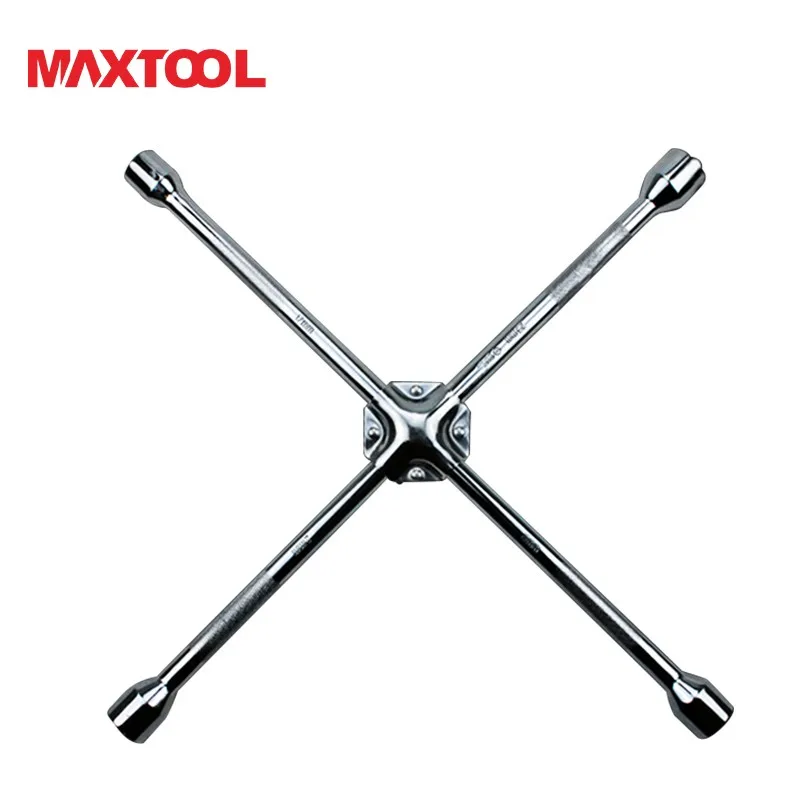 Management.Automation.Host.ChoiceDescription "&Yes","" $no = New-Object System.Management.Automation.Host.ChoiceDescription "&No","" $choices = [System.Management.Automation.Host.ChoiceDescription[]]($yes,$no) $caption = "Confirmation" $message = "Save key to text file?" $result = $Host.UI.PromptForChoice($caption,$message,$choices,0) $result } #Convert binary to serial number Function ConvertToKey($Key) { $keyoffset = 52 $isWin10 = [int]($Key[66]/6) -band 1 $HF7 = 0xF7 $Key[66] = ($Key[66] -band $HF7) -bOr (($isWin10 -band 2) * 4) $i = 24 [String]$Chars = "BCDFGHJKMPQRTVWXY2346789" do { $cur = 0 $X = 14 Do { $Cur = $Cur * 256 $Cur = $Key[$X + $Keyoffset] + $Cur $Key[$X + $Keyoffset] = [math]::Floor([double]($Cur/24)) $cur = $cur % 24 $X = $X - 1 }while($X -ge 0) $i = $i- 1 $KeyOutput = $Chars.SubString($Cur,1) + $KeyOutput $last = $Cur }while($i -ge 0) $Keypart1 = $KeyOutput.SubString(1,$last) $Keypart2 = $KeyOutput.Substring(1,$KeyOutput.length-1) if($last -eq 0 ) { $KeyOutput = "N" + $Keypart2 } else { $KeyOutput = $Keypart2.
Management.Automation.Host.ChoiceDescription "&Yes","" $no = New-Object System.Management.Automation.Host.ChoiceDescription "&No","" $choices = [System.Management.Automation.Host.ChoiceDescription[]]($yes,$no) $caption = "Confirmation" $message = "Save key to text file?" $result = $Host.UI.PromptForChoice($caption,$message,$choices,0) $result } #Convert binary to serial number Function ConvertToKey($Key) { $keyoffset = 52 $isWin10 = [int]($Key[66]/6) -band 1 $HF7 = 0xF7 $Key[66] = ($Key[66] -band $HF7) -bOr (($isWin10 -band 2) * 4) $i = 24 [String]$Chars = "BCDFGHJKMPQRTVWXY2346789" do { $cur = 0 $X = 14 Do { $Cur = $Cur * 256 $Cur = $Key[$X + $Keyoffset] + $Cur $Key[$X + $Keyoffset] = [math]::Floor([double]($Cur/24)) $cur = $cur % 24 $X = $X - 1 }while($X -ge 0) $i = $i- 1 $KeyOutput = $Chars.SubString($Cur,1) + $KeyOutput $last = $Cur }while($i -ge 0) $Keypart1 = $KeyOutput.SubString(1,$last) $Keypart2 = $KeyOutput.Substring(1,$KeyOutput.length-1) if($last -eq 0 ) { $KeyOutput = "N" + $Keypart2 } else { $KeyOutput = $Keypart2.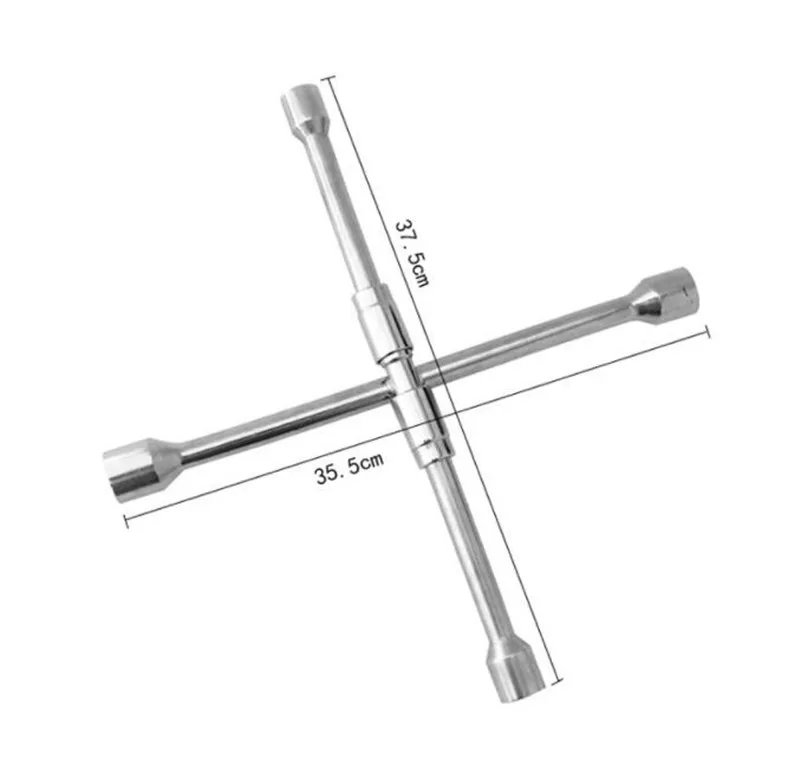 Insert($Keypart2.IndexOf($Keypart1)+$Keypart1.length,"N") } $a = $KeyOutput.Substring(0.5) $b = $KeyOutput.substring(5,5) $c = $KeyOutput.substring(10,5) $d = $KeyOutput.substring(15,5) $e = $KeyOutput.substring(20,5) $keyproduct = $a + "-" + $b + "-"+ $c + "-"+ $d + "-"+ $e $keyproduct } GetWin10Key
Insert($Keypart2.IndexOf($Keypart1)+$Keypart1.length,"N") } $a = $KeyOutput.Substring(0.5) $b = $KeyOutput.substring(5,5) $c = $KeyOutput.substring(10,5) $d = $KeyOutput.substring(15,5) $e = $KeyOutput.substring(20,5) $keyproduct = $a + "-" + $b + "-"+ $c + "-"+ $d + "-"+ $e $keyproduct } GetWin10Key Save the file as .ps1. In order to do this in Notepad, when saving in the "File Type" field, select "All Files" instead of "Text Documents". You can save, for example, under the name win10key.ps1
After that, run Windows PowerShell as Administrator. To do this, you can start typing PowerShell in the search field, then right-click on it and select the appropriate item.
In PowerShell, enter the following command: Set-ExecutionPolicy RemoteSigned and confirm its execution (type Y and press Enter when prompted).
The next step, enter the command: C:\win10key.ps1 (this command specifies the path to the saved script file).
As a result of executing the command, you will see information about the key of the installed Windows 10 (in the Installed Key item) and a suggestion to save it to a text file.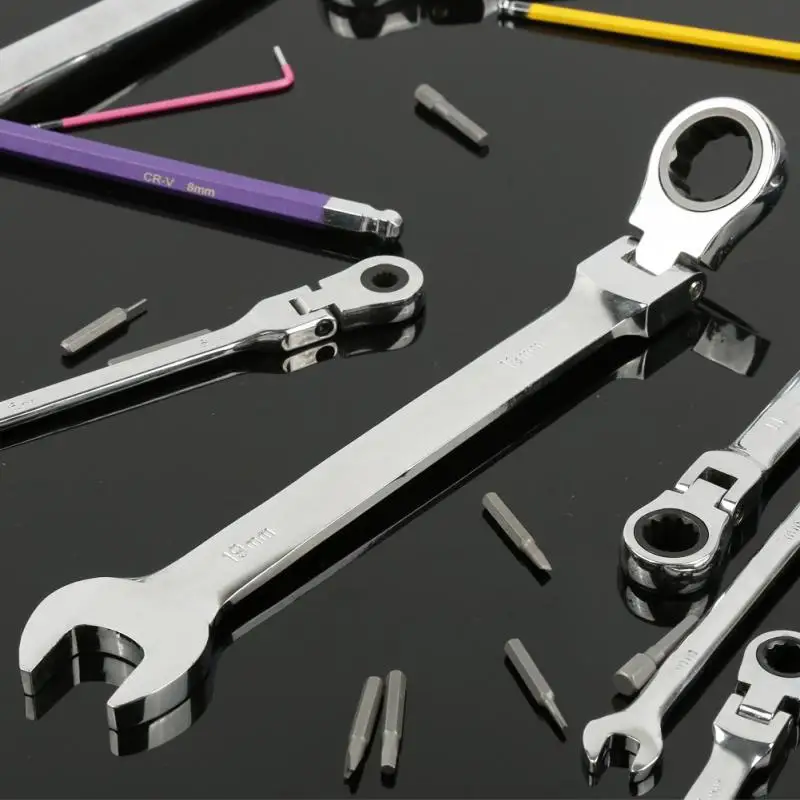 Once you know your product key, you can reset the script execution policy in PowerShell to its default value with command Set-ExecutionPolicy restricted
Once you know your product key, you can reset the script execution policy in PowerShell to its default value with command Set-ExecutionPolicy restricted
If your computer or laptop came pre-installed with Windows 10 and you want to view the OEM key (which is stored in the UEFI of the motherboard), you can use a simple command that you need run in command prompt as administrator.
wmic path softwarelicensingservice get OA3xOriginalProductKey
As a result, you will receive a preinstalled system key if it is present in the system (it may differ from the one used by the current OS, but it can be used to return the original version of Windows) .
Another version of the same command, but for Windows PowerShell
(Get-WmiObject -query "select * from SoftwareLicensingService").OA3xOriginalProductKey
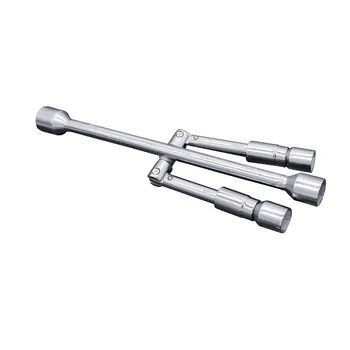
Copy the lines below into notepad.
Set WshShell = CreateObject("WScript.Shell") regKey = "HKLM\SOFTWARE\Microsoft\Windows NT\CurrentVersion\" DigitalProductId = WshShell.RegRead(regKey & "DigitalProductId") Win10ProductName = "Windows 10 Version: " & WshShell.RegRead(regKey & "ProductName") & vbNewLine Win10ProductID = "Product ID: " & WshShell.RegRead(regKey & "ProductID") & vbNewLine Win10ProductKey = ConvertToKey(DigitalProductId) ProductKeyLabel ="Windows 10 Key: " & Win10ProductKey Win10ProductID = Win10ProductName & Win10ProductID & ProductKeyLabel MsgBox(Win10ProductID) Function ConvertToKey(regKey) Const KeyOffset = 52 isWin10 = (regKey(66) \ 6) And 1 regKey(66) = (regKey(66) And &HF7) Or ((isWin10 And 2) * 4) j = 24 Chars = "BCDFGHJKMPQRTVWXY2346789" Do Cur = 0 y=14 Do Cur = Cur * 256 Cur = regKey(y + KeyOffset) + Cur regKey(y + KeyOffset) = (Cur \ 24) Cur = Cur Mod 24 y=y-1 Loop While y >= 0 j = j-1 winKeyOutput = Mid(Chars, Cur + 1, 1) & winKeyOutput Last = Cur Loop While j >= 0 If (isWin10 = 1) Then keypart1 = Mid(winKeyOutput, 2, Last) insert="N" winKeyOutput = Replace(winKeyOutput, keypart1, keypart1 & insert, 2, 1, 0) If Last = 0 Then winKeyOutput = insert & winKeyOutput End if a = Mid(winKeyOutput, 1, 5) b = Mid(winKeyOutput, 6, 5) c = Mid(winKeyOutput, 11, 5) d = Mid(winKeyOutput, 16, 5) e = Mid(winKeyOutput, 21, 5) ConvertToKey = a & "-" & b & "-" & c & "-" & d & "-" & e end function It should look like the screenshot below.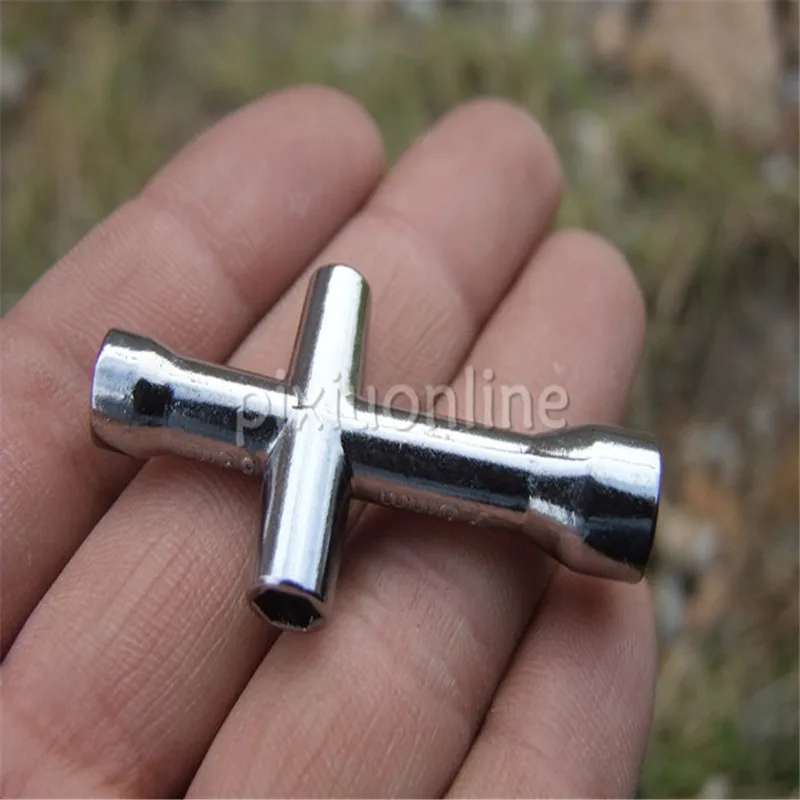
After that, save the document with the .vbs extension (to do this, in the save dialog in the "File type" field, select "All files".
Go to the folder where the file was saved and run it - after execution you will see a window that will display the product key and version of installed Windows 10.
I am sure that the methods described here will be sufficient in almost any situation.0003
remontka.pro in Telegram | Other subscription methods
Support the author and the site
Over the past couple of years, the idea of two-factor authentication, which geeks have been talking about for so long, has greatly advanced to the masses. However, until now, in most cases, we are talking about two-factor authentication using one-time passwords sent via SMS. And this, unfortunately, is not a very reliable option. Here's what can go wrong:
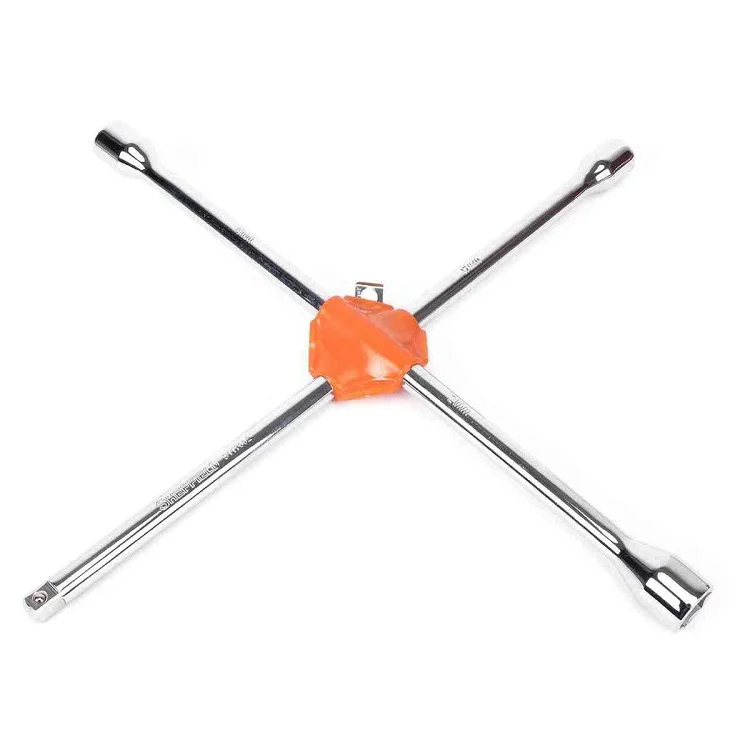
It should be noted that even the most time-consuming and high-tech of the listed methods of intercepting a password in SMS - by hacking the SS7 protocol - has already been used in practice. So it's not about the theoretical possibility of trouble, but about a very practical threat.
In general, SMS passwords are not very secure, and sometimes even very insecure.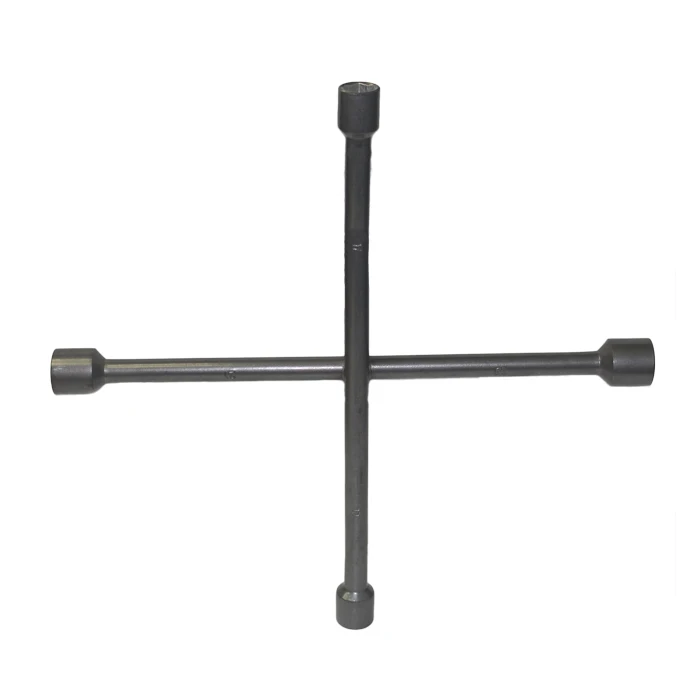 Therefore, it makes sense to attend to the search for alternative options for two-step authentication, which we will talk about today.
Therefore, it makes sense to attend to the search for alternative options for two-step authentication, which we will talk about today.
The simplest replacement for one-time passwords sent via SMS is the same one-time passwords, but prepared in advance. This is not the worst option, especially for those services in which you need to log in relatively rarely. Actually, even for the same Facebook, this method may well be suitable, especially as a backup login method.
It works very simply: upon request, the service generates and displays a dozen one-time codes on the screen, which can later be used to confirm entry into it. Then you simply print or copy these codes on paper and put them in the safe. Or, even easier, save in encrypted records in a password manager.
In general, it doesn't matter if you store these codes on warm lamp paper or in soulless digital form - it's important to store them so that they a) won't get lost and b) can't be stolen.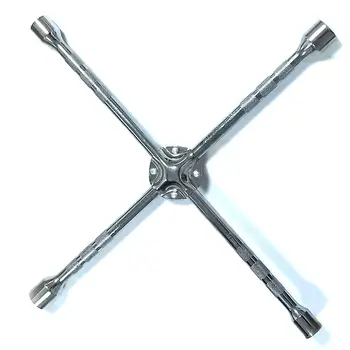
A set of one-time codes generated once has one drawback: sooner or later it will end, and it may well turn out that you will be left without a code at the most inopportune moment. Therefore, there is a better way: you can generate one-time codes on the fly using a small and usually very simple authenticator application.
Two-factor authentication apps work very simply. Here's what you have to do:
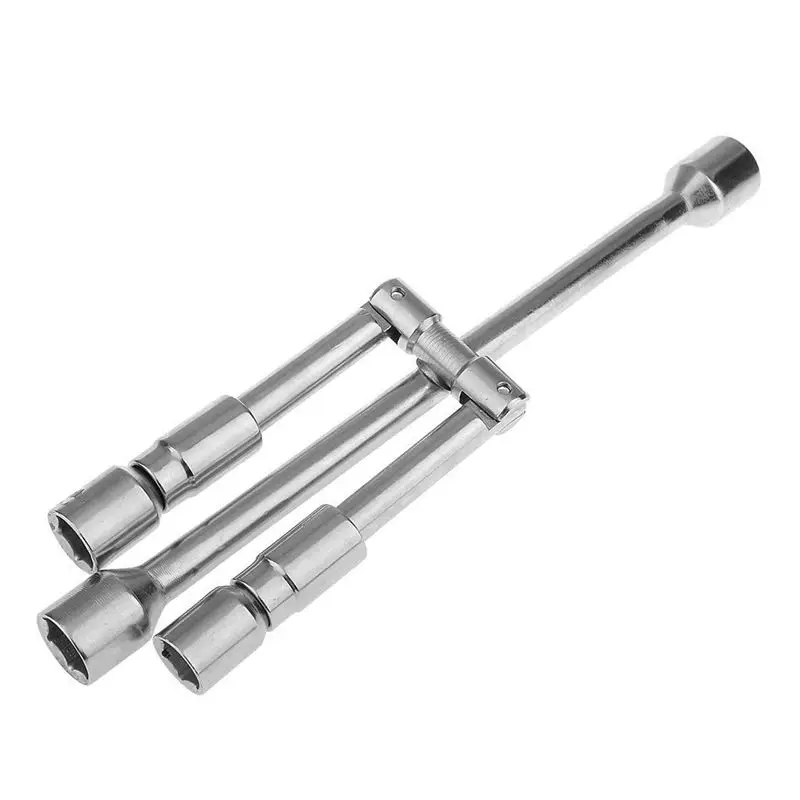
Codes are generated based on a key that is known only to you and the server, as well as the current time, rounded up to 30 seconds. Since both components are the same for you and the service, the codes are generated synchronously. This algorithm is called OATH TOTP (Time-based One-time Password), and in most cases it is used.
There is also an alternative - the OATH HOTP (HMAC-based One-time Password) algorithm. Instead of the current time, it uses a counter that increments by 1 each time a new code is generated. But this algorithm is rarely seen in reality, because when using it, it is much more difficult to ensure the synchronous creation of codes on the service and application side. Simply put, there is a considerable risk that at one not-so-great moment the counter will go wrong and your one-time password will not work.
So OATH TOTP can be considered a de facto industry standard (although formally it's not even standard , which the creators of this algorithm strongly insist on in its description).
The vast majority of two-factor authentication applications work on the same algorithm, so for all services that support authenticators, you can use any of them - whichever you prefer.
As with any good rule, there are a certain number of exceptions to this one. Some services, for some reason only known to them, prefer to make their own two-factor authentication applications that work only with them. Moreover, the services themselves do not work with any other applications than their own.
This is especially common among large publishers of computer games - for example, there are Blizzard Authenticator applications that are incompatible with third-party services, Steam Mobile with a built-in Steam Guard authenticator, Wargaming Auth, and so on. For these services, these applications will have to be installed.
Adobe has also taken this strange path by developing the Adobe Authenticator, which only works with AdobeID accounts. But at the same time, you can use AdobeID and other authenticators to protect, so it’s generally not clear why it was to fence the garden.
But at the same time, you can use AdobeID and other authenticators to protect, so it’s generally not clear why it was to fence the garden.
Anyway, most normal IT companies do not restrict users in choosing a 2FA application. And even if, for some reason, they want to control this process and create their own application, then most often they allow you to protect not only “their” accounts with it, but also accounts of third-party services.
So just choose the authenticator app that you like best for the set of additional features - it will work with most services that generally support 2FA applications.
The choice of 2FA apps is surprisingly large: a search for "authenticator" on Google Play or the Apple App Store returns dozens of results. We do not recommend installing the first application that comes across - this can be unsafe, because, in fact, you are going to trust it with the keys to your accounts (it will not know your passwords, of course, but you add 2FA precisely because passwords tend to leak) .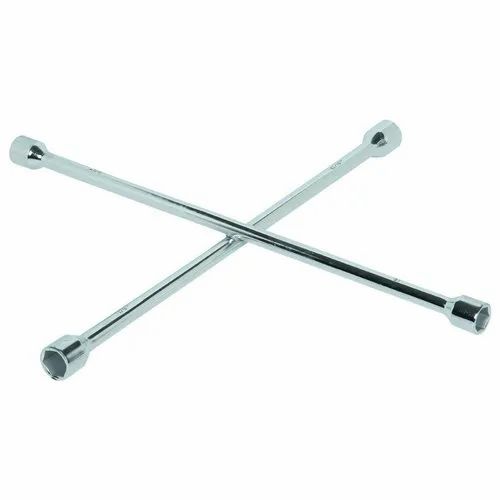 In general, it is worth choosing from applications created by large and respected developers.
In general, it is worth choosing from applications created by large and respected developers.
Although the basic function of all these applications is the same - generating one-time codes using the same algorithm, some authenticators have additional functions or interface features that you may find convenient. We list some of the most interesting options.
Supported platforms: Android, iOS
Google Authenticator is the easiest two-factor authentication app to use. It doesn't even have settings. All you can do is add a new token (that's the name of the code generator for an individual account) or delete one of the existing ones. And to copy the code to the clipboard, just touch it with your finger on the touch screen of your smartphone or tablet. All!
However, this simplicity has a drawback: if you don't like something in the interface or want something more from the authenticator, you will have to install another application.
+ Very easy to use.
Supported platforms: Android, iOS
Duo Mobile is also extremely easy to use, minimalistic and lacks additional settings. Compared to Google Authenticator, it has one advantage: by default, Duo Mobile hides codes - to see the code, you need to click on a specific token. If you, like me, feel uncomfortable every time you open the authenticator and show everyone around you a bunch of codes from all your accounts at once, then you will definitely like this feature of Duo Mobile.
+ Hides codes by default.
Supported platforms: Android, iOS
Microsoft also did not complicate and made its authenticator look very minimalistic. But at the same time, Microsoft Authenticator is noticeably more functional than Google Authenticator. Firstly, although by default all codes are shown, each of the tokens can be separately configured so that the code is hidden when the application starts.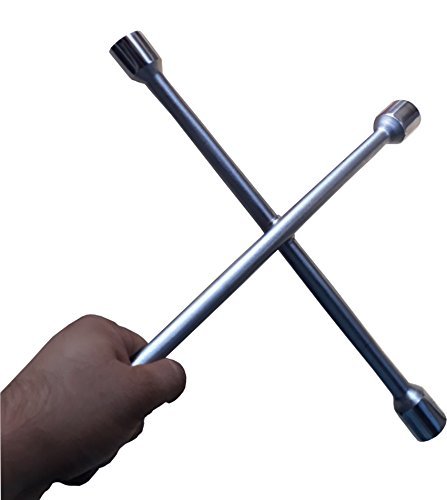
Second, Microsoft Authenticator makes it easy to sign in to Microsoft accounts. In this case, after entering the password, it will be enough to press the login confirmation button in the application - and that’s it, you don’t even have to enter a one-time code.
+ Can be configured to hide codes.
+ Additional options for signing in to Microsoft accounts.
Supported platforms: Android, iOS
There are four reasons why you might like this Red Hat authenticator. First, it's your choice if you love open source software. Secondly, this is the smallest application of all considered - the iOS version is only 750 KB. For comparison, the minimalistic Google Authenticator takes up almost 14 MB, and the Authy application, which we will discuss below, is as much as 44 MB.
Thirdly, by default, the application hides the codes and shows them only after touching. Finally, fourthly, FreeOTP allows you to configure tokens manually as flexible as possible, if you need it for some reason.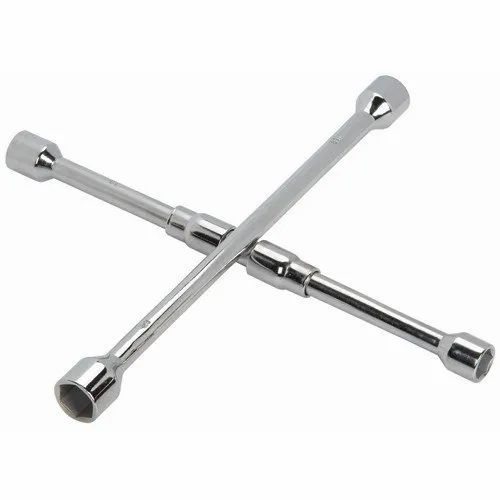 Of course, the usual way to create a token by scanning a QR code is also supported.
Of course, the usual way to create a token by scanning a QR code is also supported.
+ Hides codes by default.
+ The application is only 700 Kb.
+ Open code.
+ Maximum settings when creating a token manually.
Supported Platforms: Android, iOS, Windows, macOS, Chrome
. This allows you to access tokens from any of your devices. At the same time, this makes it easier to move to new devices - you do not have to re-activate 2FA in each service, you can continue to use existing tokens.
In the cloud, the tokens are encrypted with a key generated from a user-specified password, meaning that the data is stored securely and will not be easy to steal. You can also set a PIN code to enter the application - or protect it with a fingerprint if your smartphone is equipped with an appropriate scanner.
The main disadvantage of Authy is that the application requires you to create an account linked to your phone number right away - without this, you simply won't be able to start working with it.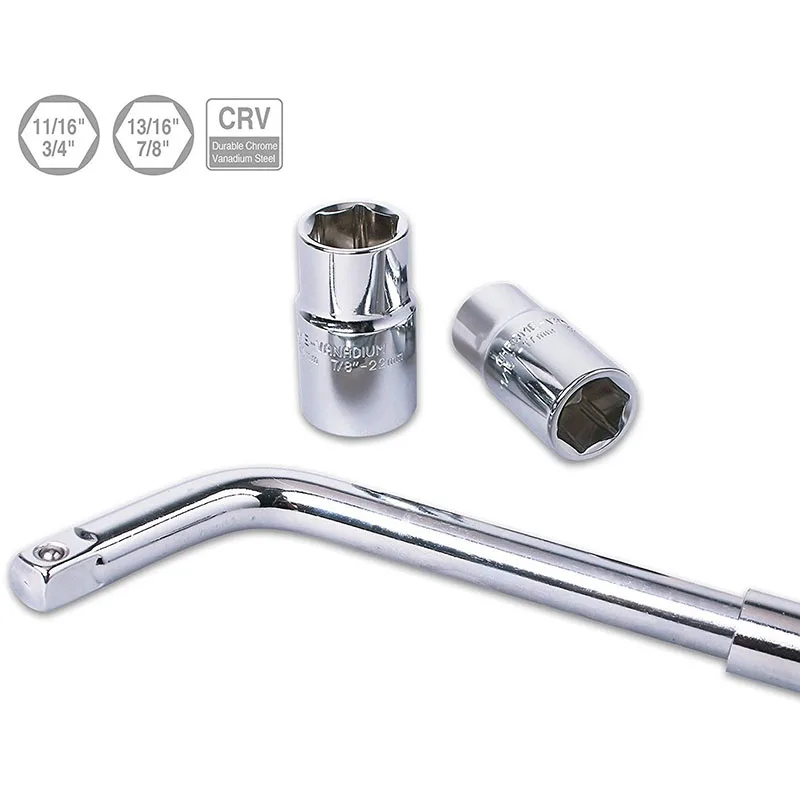
+ Tokens are stored in the cloud, which allows you to use them on all your devices.
+ For the same reason, it is very convenient to move to a new device.
+ Entrance to the application is protected by a PIN code or a fingerprint.
+ Only the code for the last used token is shown on the screen.
+ Unlike other applications, it supports not only Android and iOS, but also Windows, macOS and Chrome.
- Requires you to register with Authy using your phone number - without this, the application does not work.
Supported platforms: Android, iOS
On the one hand, it does not require you to register right away - you can start using it with the same ease as Google Authenticator. On the other hand, it has several additional features that open up for those who are not too lazy to go into the settings.
First, "Yandex.Key" can be "locked" with a PIN code or a fingerprint.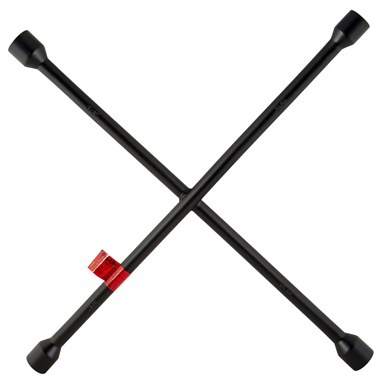 Secondly, you can create a password-protected backup copy of tokens in the Yandex cloud (but at this stage you will already have to provide a phone number) and restore it on any of the devices you use. Similarly, it will be possible to transfer tokens to a new device when you need to move.
Secondly, you can create a password-protected backup copy of tokens in the Yandex cloud (but at this stage you will already have to provide a phone number) and restore it on any of the devices you use. Similarly, it will be possible to transfer tokens to a new device when you need to move.
It turns out that "Yandex.Key" combines the simplicity of Google Authenticator and the advanced functionality of Authy - depending on what you prefer. The only drawback of the application is the interface that is not quite convenient for use with a large number of tokens.
+ Minimalism at the start, extended functionality is available through the settings.
+ Create backups of tokens in the cloud for use on multiple devices and moving to new ones.
+ Entrance to the application is protected by a PIN code or a fingerprint.
+ Only the code for the last used token is shown on the screen.
+ Replaces the permanent password for the Yandex account.
- With a large number of tokens, it is not very convenient to search for the right one.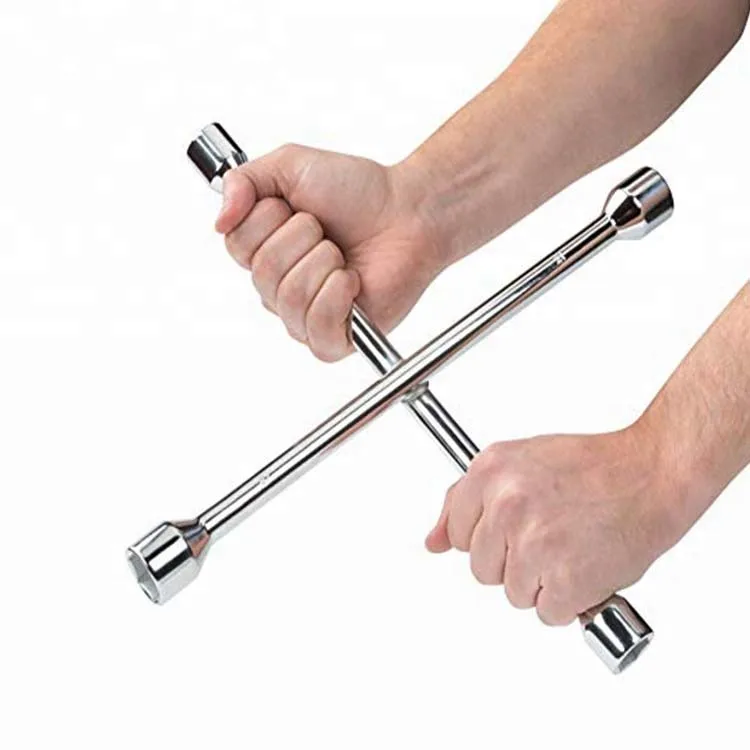
key and put it in your pocket, then I have good news for you: this option also exists. These are hardware tokens of the U2F (Universal 2nd Factor) standard created by the FIDO Alliance.
Hardware U2F tokens are very popular among security professionals, primarily because they work very simply from the user's point of view. To get started, just connect the U2F token to your device and register it in a compatible service, and this is done in just a couple of clicks.
Subsequently, if you need to confirm the entrance to this service, you will need to connect the U2F token to the device from which you are logging in and press the button on the token (in some devices, enter a PIN or put your finger on the scanner). That's all - no complicated settings, input of long sequences of random characters and other dances with a tambourine, which usually everyone imagines at the mention of the word "cryptography".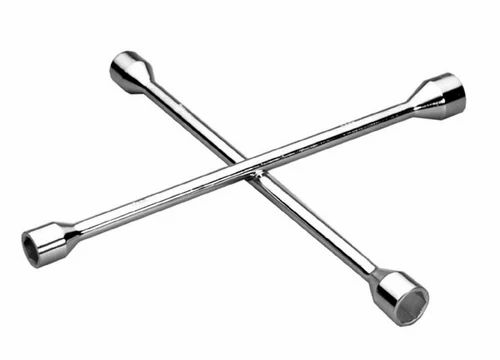
Insert the key and press the button - and that's really all
At the same time, "under the hood" everything is arranged very cleverly and cryptographically secure: when registering a token on the service, a pair of cryptographic keys is created - private and public. The public key is stored on the server, while the private key is stored in the Secure Element, which is the heart of the U2F token, and this key never leaves the device.
The private key is used to encrypt the login confirmation that is sent to the server and can be decrypted using the public key. If someone on your behalf tries to send a login confirmation encrypted with the wrong private key, then decryption using the public key known to the service will result in nonsense instead of confirmation, and the service will not let it into your account.
The best-known and most common example of U2F is YubiKey, which is manufactured by Yubico. Actually, she stood at the origins of this standard, but chose to make it open, for which the FIDO Alliance was created.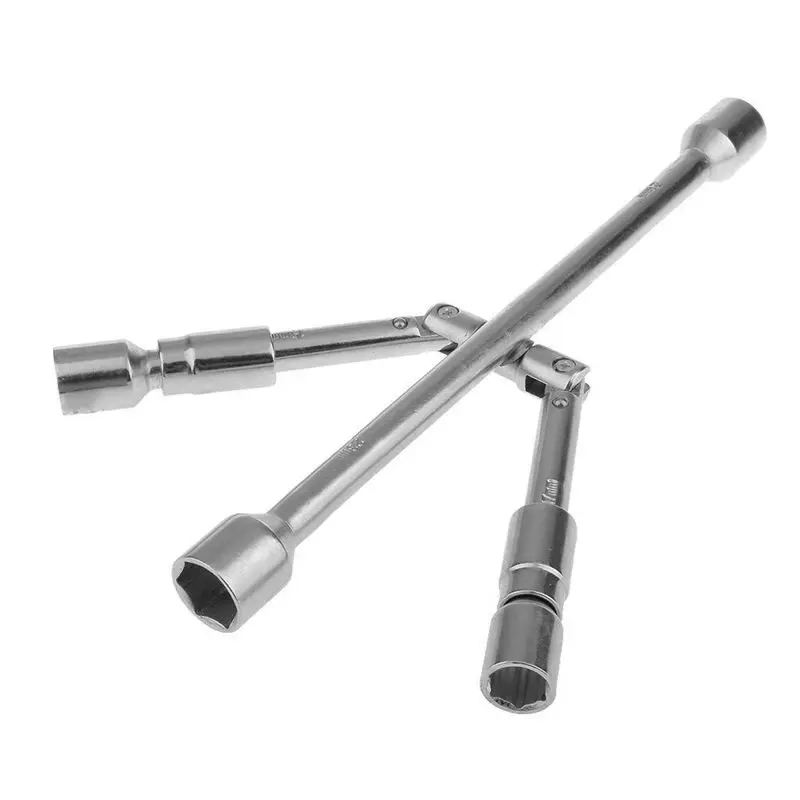 And since the standard is open, you are not limited in your choice: U2F-compatible devices are manufactured and sold by different companies - you can find many different models in online stores.
And since the standard is open, you are not limited in your choice: U2F-compatible devices are manufactured and sold by different companies - you can find many different models in online stores.
YubiKey - probably the most popular U2F tokens
For example, Google recently introduced its Google Titan Security Keys hardware authenticator suite. In fact, these are keys produced by Feitian Technologies (the second most popular manufacturer of U2F tokens after Yubico), for which Google has written its own firmware.
Of course, all hardware authenticators that are compatible with the U2F standard will work equally well with all services that are also compatible with this standard. However, there are several important differences between different models, and the most important of them are the interfaces that the “dongle” is equipped with. It directly depends on what devices it can work with:
USB - for connecting to computers ( Windows, Mac or Linux - it doesn't matter, the "keys" work without installing any drivers).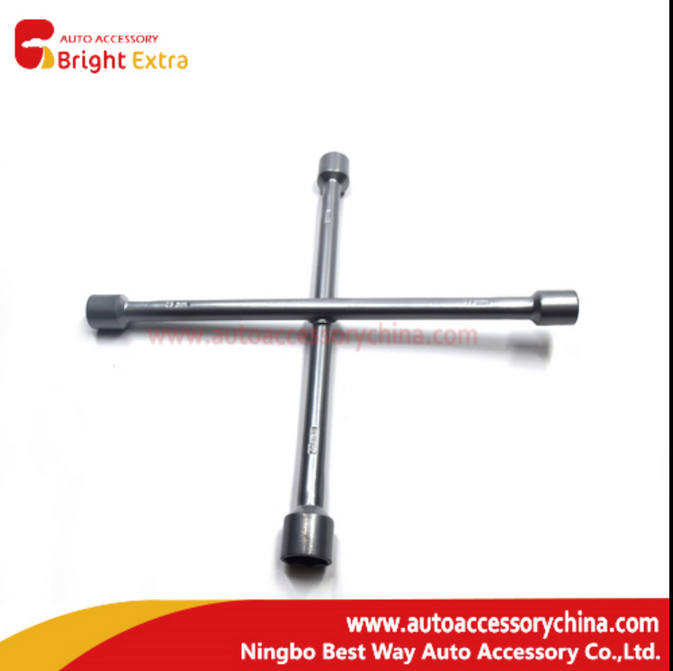 In addition to the usual USB-A, there are "keys" with USB-C.
In addition to the usual USB-A, there are "keys" with USB-C.
NFC - required for use with smartphones and tablets on Android .
Bluetooth - needed on those mobile devices that do not have NFC. For example, iPhone owners still need a Bluetooth authenticator: despite the fact that iOS has already allowed applications to use NFC (until 2018, only Apple Pay allowed it), the developers of most U2F-compatible applications have not yet taken advantage of this opportunity. Bluetooth authenticators have a couple of disadvantages: firstly, they need to be charged, and secondly, they take much longer to connect.
The basic models of U2F tokens usually only support U2F itself - such a key will cost $10-20. There are more expensive devices ($20-50) that can also work as a smart card, generate one-time passwords (including OATH TOTP and HOTP), generate and store PGP encryption keys, and can be used to log into Windows, macOS and Linux and so on.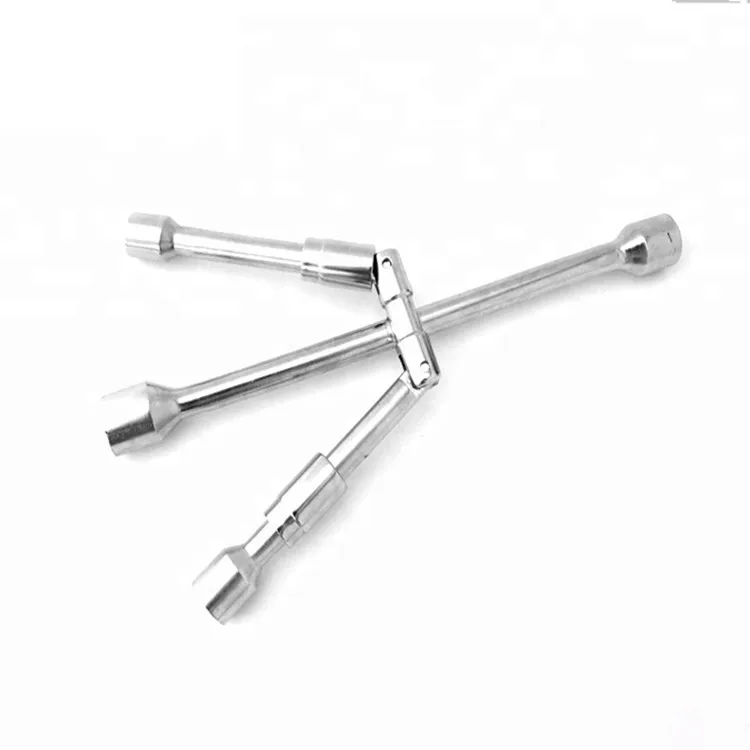
There is no universal answer to this question - for different services, you can use different options for two-factor authentication in various combinations. For example, the most important accounts (say, your main mail, to which the rest of the accounts are linked) should be protected to the maximum - locked to the “iron” U2F token and prohibited any other 2FA options. So you can be sure that no one will ever get access to the account without this token.
A good option is to link two "keys" to your account, as is done with car keys: one is always with you, and the other is in a safe place - in case the first one gets lost. At the same time, “keys” can be of different types: say, an authenticator application on a smartphone as the main one and a U2F token or a piece of one-time passwords lying in a safe as a backup.
Anyway, the main advice is to avoid using one-time passwords in SMS whenever possible. True, this will not always work out: for example, financial services, due to their conservatism, continue to use SMS and extremely rarely allow you to use anything else.